|
Postcards from:
Big Bear Lake USA
San Jose Costa Rica
Granada Nicaragua
Managua Nicaragua
San Salvador ElSalvador
Tegucigalpa Honduras
San Pedro Sula Honduras
Copan Ruinas Honduras
La Ceiba Honduras
Utila Island Honduras
La Ceiba Honduras
San Pedro Sula Honduras
Belmopan Belize
Belize City Belize
Orange Walk Belize
Lamanai
Mayan Ruins
Panama City Panama
Bogata Colombia
Cali Colombia
Popayan Colombia
Ipiales Colombia
Quito Ecuador
Galapagos Is. Ecuador
Puerto Ayoro Galapagos
Guayaquil Ecuador
Cuenca Ecuador
Tumbes Peru
Lima Peru
Nazca Peru
Cuzco Peru
Ollantaytambo Peru
Machu Picchu Peru
Machu Picchu Photos
Cuzco Again
Lake Titicaca Peru
Lake Titicaca Photos
Copacabana Bolivia
La Paz Bolivia
Arica Chile
Iquique Chile
Antofagasta Chile
Santiago Chile 1
Valparaiso Chile
Santiago Chile 2
Easter Island Chile
Santiago Chile 3
Chillan Chile
Valdivia Chile
Puerto Montt Chile
Castro Chile
Chaiten Chile
Coyhaique Chile
Puerto Chacabuco Chile
Coyhaique Chile
Punta Arenas Chile
Puerto Natales Chile
Punta Arenas Chile
Puerto Williams Chile
Ushuaia Argentina
Buenos Aires Argentina
Puerto Iguazu Argentina
Montevideo Uruguay
Colonia Uraguay
Caracas Venezuela
Ciudad Bolivar Venezuela
Puerto Ordaz Venezuela
Porlamar Venezuela
PortOSpain Trinidad
Georgetown Guyana
Corriverton Guyana
Paramaribo Suriname
Cayenne French Guiana
Pointa A Pitre Guadaloupe
Gosier Guadeloupe
Dominican Republic
Miami Florida
Back Home in California
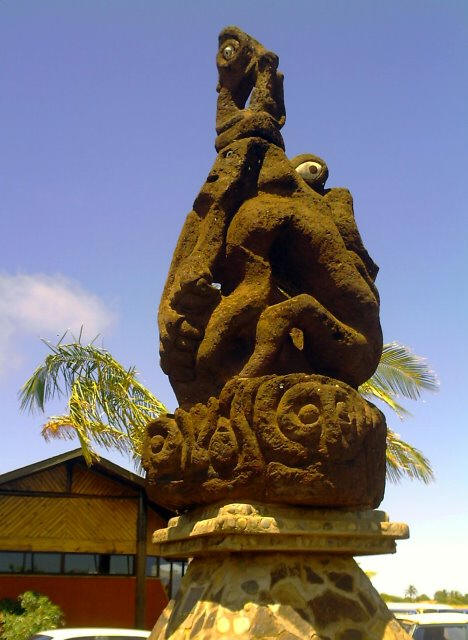
Easter Island: Sculpture on the beach near my first hotel, the $100 Taha
Tai.
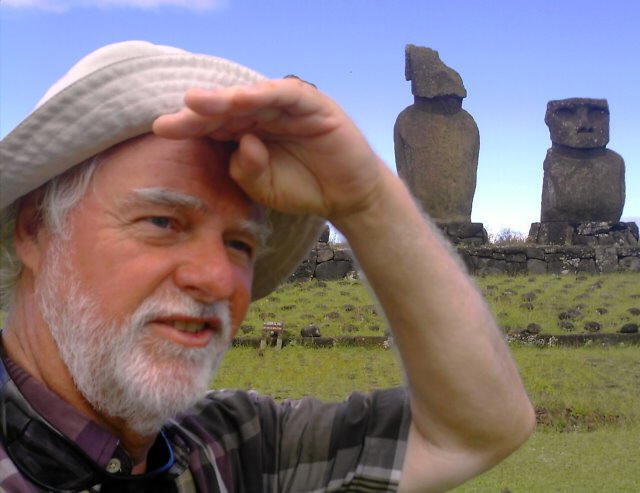
Easter Island: The Tahai Moai is that'a way. It is one of the few completely
restored sculptures on the island.

Easter Island: International flags at the entrance to my first hotel,
the $100 Taha Tai.

Easter Island: Modern sculpture on the grounds of my first hotel, the
$100 Taha Tai.
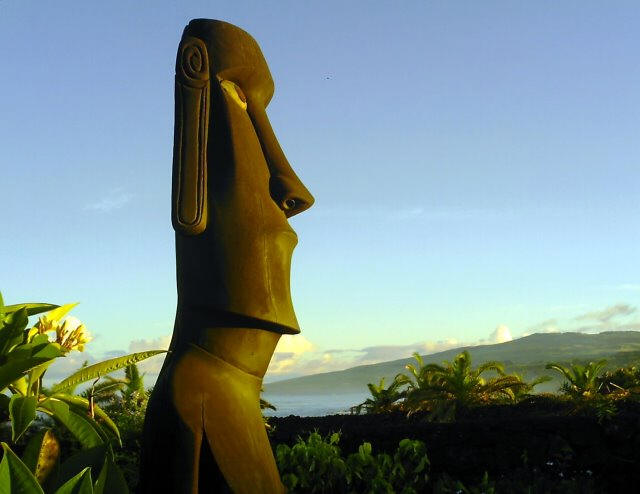
Easter Island: Modern sculpture on the grounds of my first hotel, the
$100 Taha Tai.
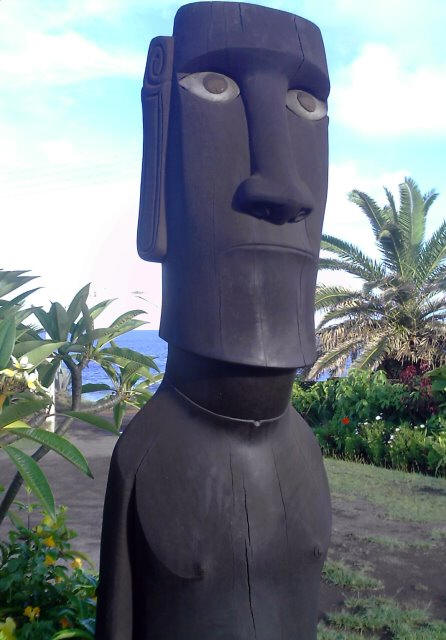
Easter Island: Modern sculpture on the grounds of my first hotel, the
$100 Taha Tai.
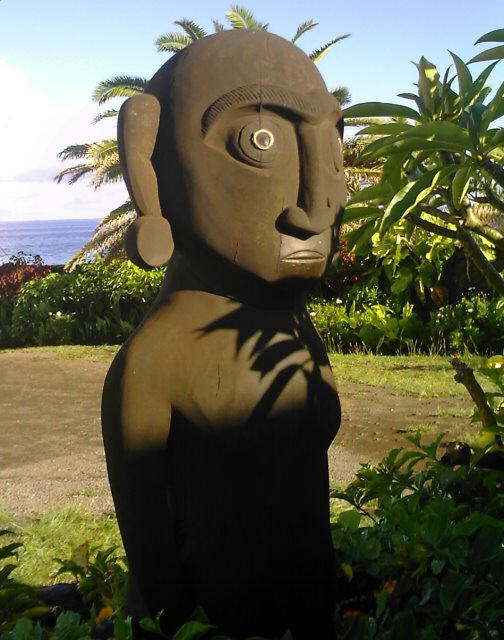
Easter Island: Modern sculpture on the grounds of my first hotel, the
$100 Taha Tai.
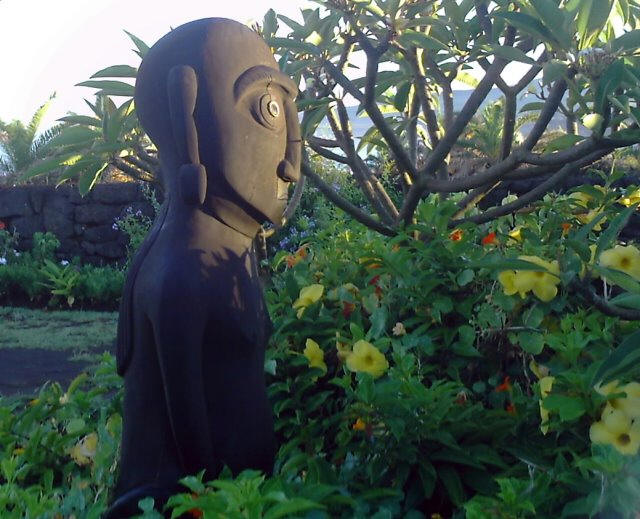
Easter Island: Modern sculpture on the grounds of my first hotel, the
$100 Taha Tai.
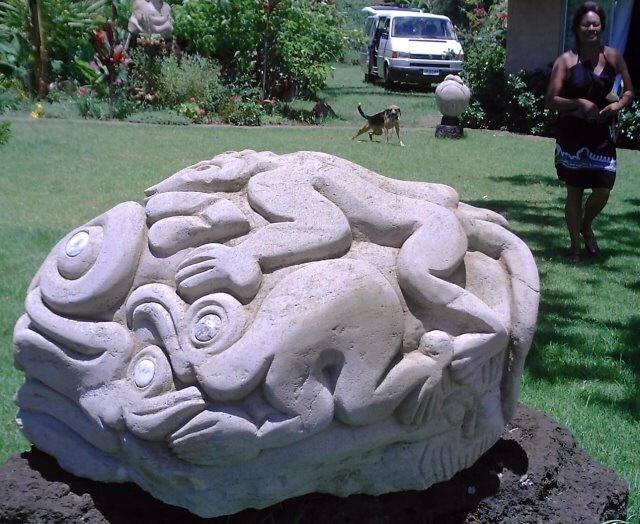
Easter Island: Modern sculpture on the grounds of my first hotel, the
$100 Taha Tai.
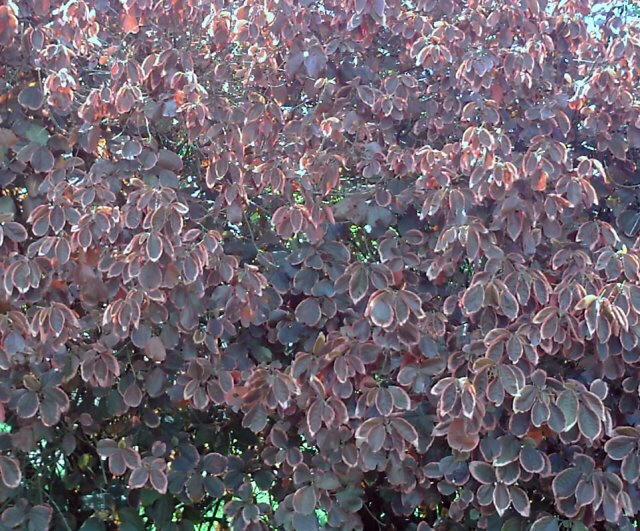
Easter Island: Unique bush on the grounds of my first hotel, the $100
Taha Tai.
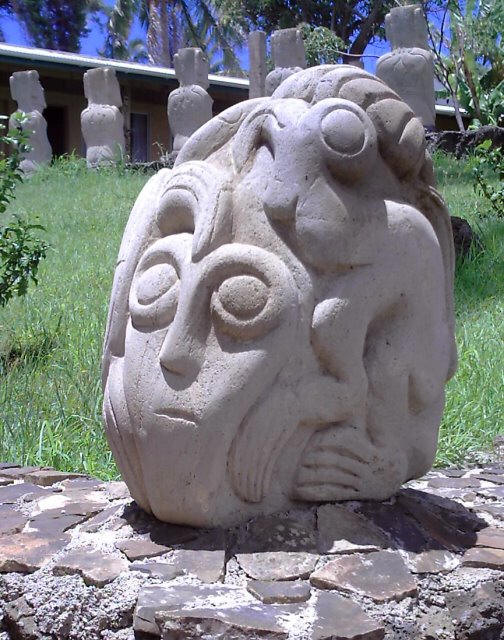
Easter Island: Modern sculpture on the grounds of my first hotel, the
$100 Taha Tai.
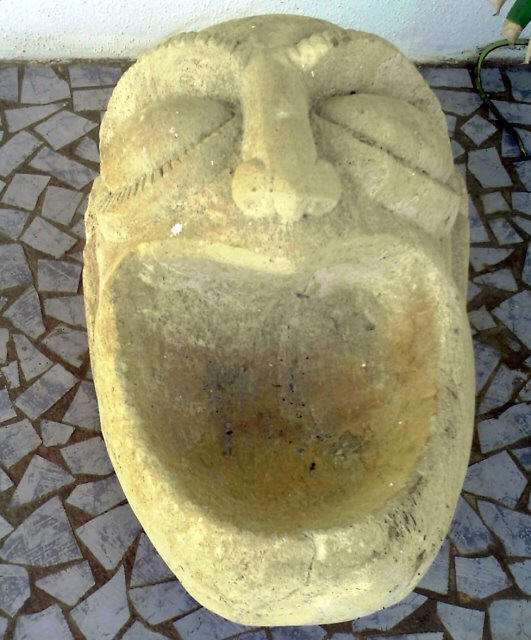
Easter Island: Modern sculpture on the grounds of my first hotel, the
$100 Taha Tai. I saw quite a few of these bowls, for what purpose I have
no idea.
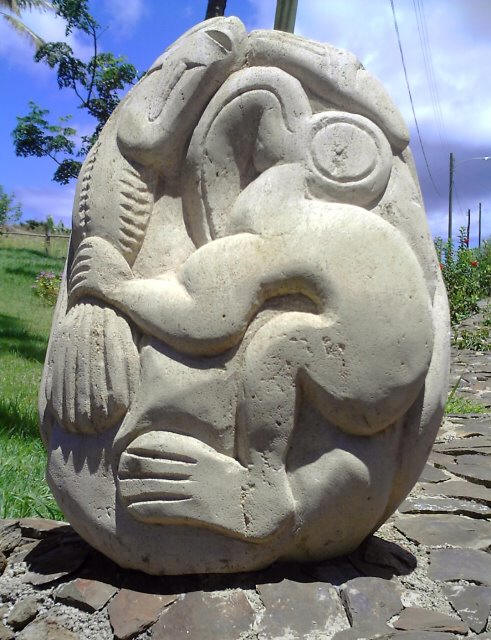
Easter Island: Modern sculpture on the grounds of my first hotel, the
$100 Taha Tai.
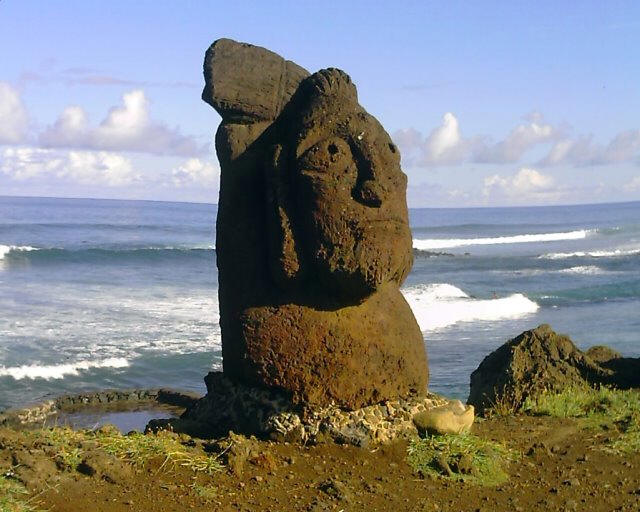
Easter Island: Sculpture on the beach near my first hotel, the $100 Taha
Tai.
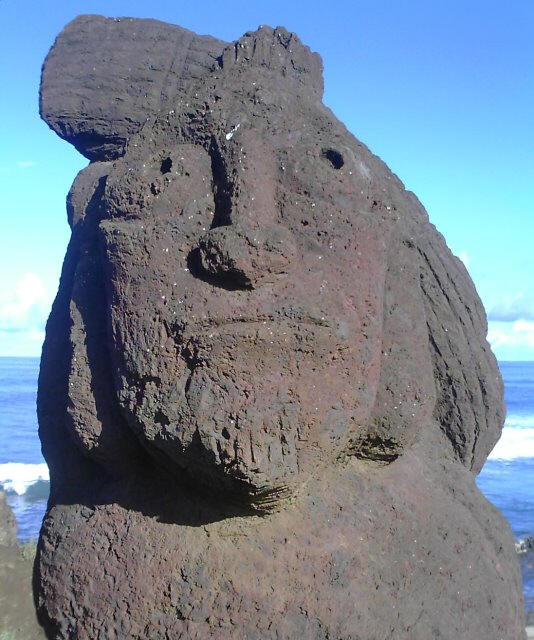
Easter Island: Sculpture on the beach near my first hotel, the $100 Taha
Tai.
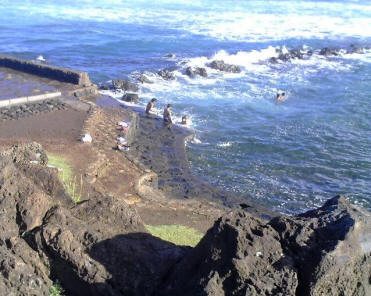
Easter Island: Looking down on the old swimming hole. Self portrait of
the photographer's shadow.

Easter Island: Entrance to the Via Moana Hotel where I discovered
several modern sculptures characteristic of the island culture.
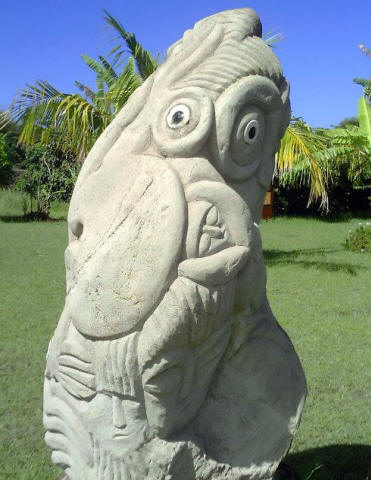
Easter Island: On the grounds of the Via Moana Hotel I discovered
several modern sculptures characteristic of the island's style.
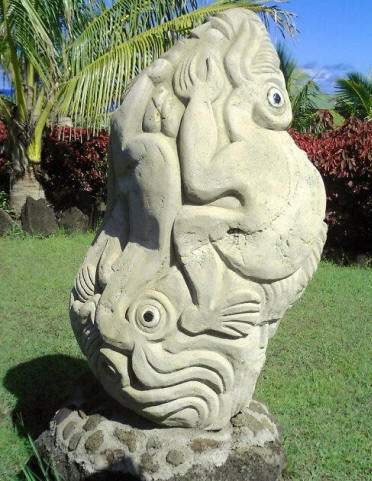
Easter Island: On the grounds of the Via Moana Hotel I discovered
several modern sculptures characteristic of the island's style.
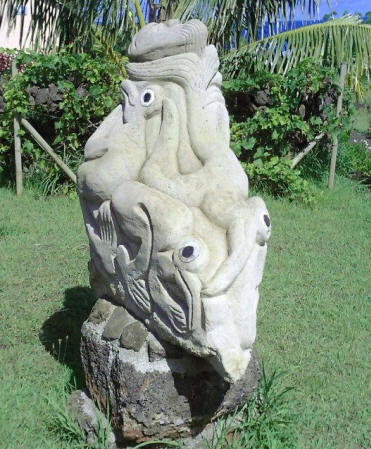
Easter Island: On the grounds of the Via Moana Hotel I discovered
several modern sculptures characteristic of the island's style.
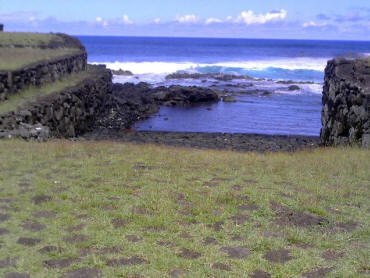
Easter Island: Near the Tahai Moai are the remains of what appears to be
a boat ramp. At the bottom is a tide pool, however.
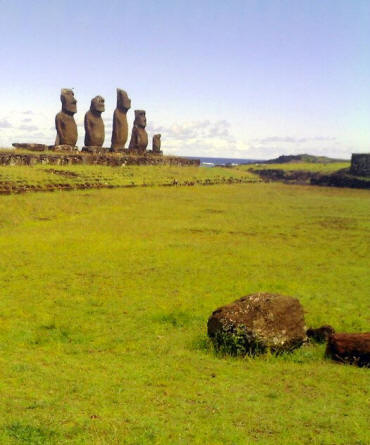
Easter Island: This group of five stand near the Tahai Moai, one of the
few completely restored sculptures on the island. The ground is really
covered with this bright yellow vegetation.
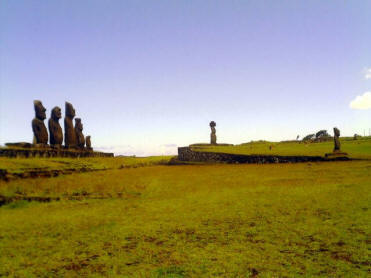
Easter Island: This group of five stand near the Tahai Moai seen in the
background.
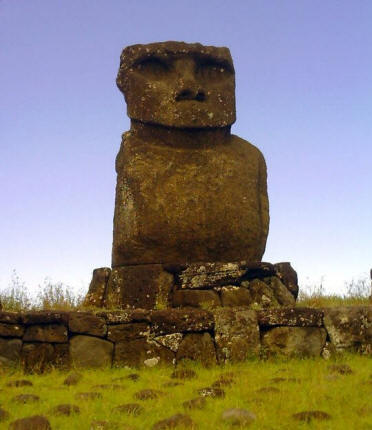
Easter Island: One of the five badly weathered moai stand near the
completely restored Tahai Moai out of view to the right.
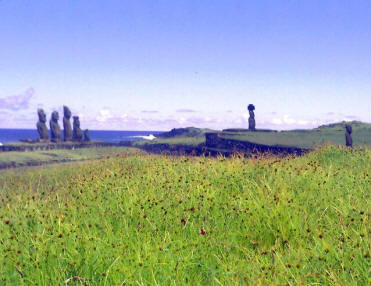
Easter Island: On the rocky western shoreline stand the Tahai Moai
group, not more than a ten minute walk from the second place I stayed.
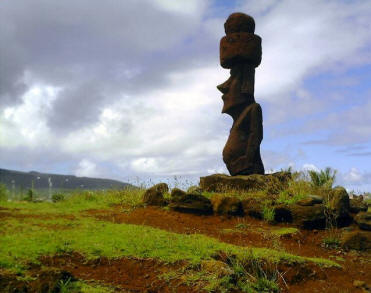
Easter Island: The Tahai Moai, one of the few completely restored
sculptures on the island.
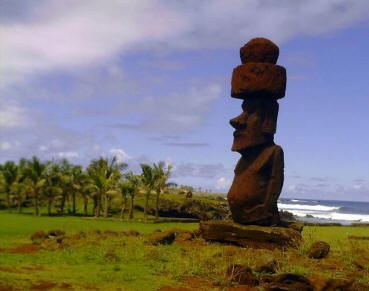
Easter Island: Another shot of the Tahai Moai, one of the few completely
restored sculptures on the island.
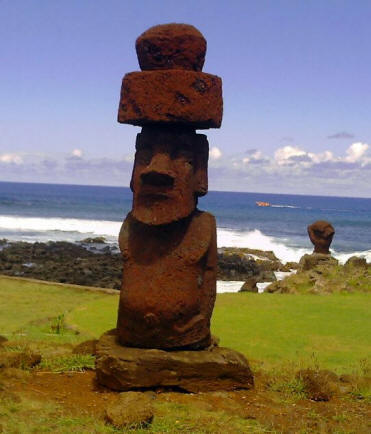
Easter Island: The Tahai Moai from another angle, one of the few
completely restored sculptures on the island.
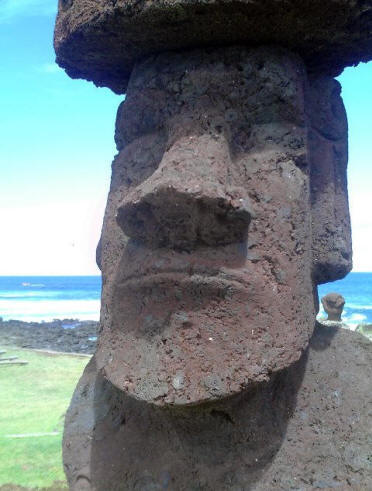
Easter Island: Up close and personal: the Tahai Moai, one of the few
completely restored sculptures on the island.
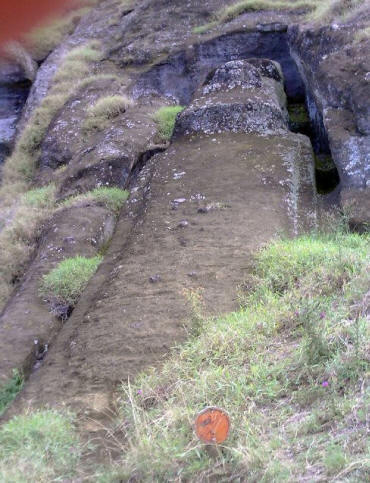
Easter Island: At the Rano Raraku volcano this giant unfinished moai
remains for eternity stuck in the rock.

Easter Island: A modern sculpture on the beach.

Easter Island: A modern sculpture on the beach.
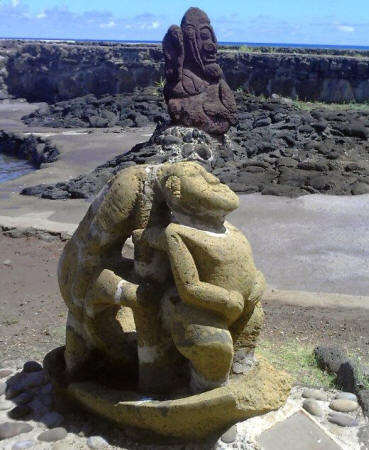
Easter Island: Another modern sculpture on the beach.
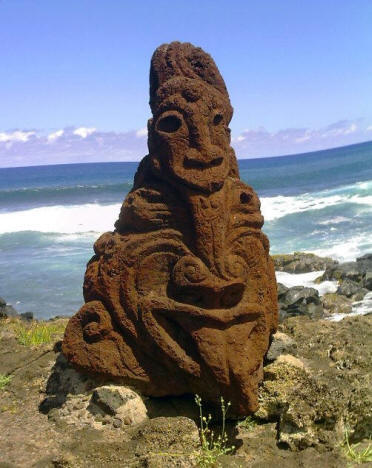
Easter Island: Modern sculpture on the beach. This entire island is a
veritable outdoor sculpture garden.
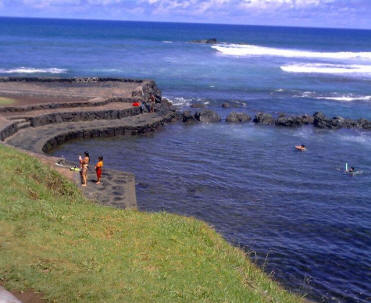
Easter Island: The old swimming hole.
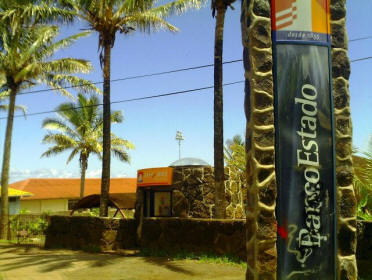
Easter Island: The island has a single banking facility. This outdoor
ATM finally made its appearance a couple years ago.
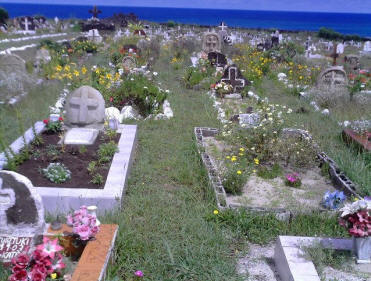
Easter Island: Cemetery. Even on Rapa Nui people die and this is the
final resting place.
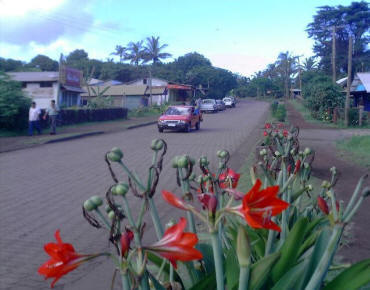
Easter Island: Main street, Hanga Roa Rapa Nui. Actually, this is the
only town on the island, so why give it a separate name?
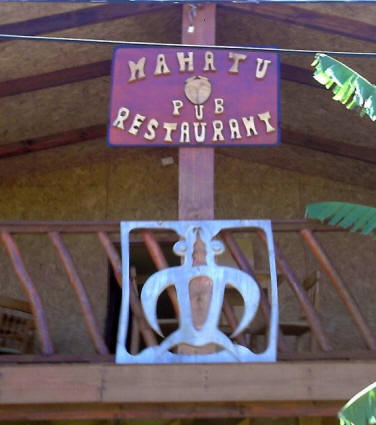
Easter Island: Sign over the entrance to a restaurant where I had the
worst "Club Sandwich" in my life. For $11 I got a hamburger bun with
wilted lettuce, wilted tomato slices and a thin slice of fried beef. A
surly college age kid threw the thing on the table and then added a 10%
service charge to the bill... which I refused to pay.
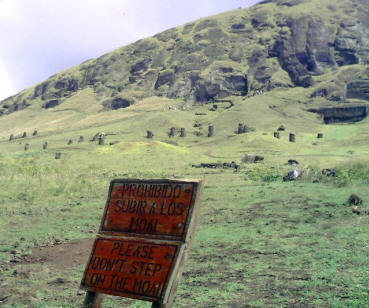
Easter Island: At the Rano Raraku volcano hundreds of both finished and
unfinished moai are located both inside and out of the crater.
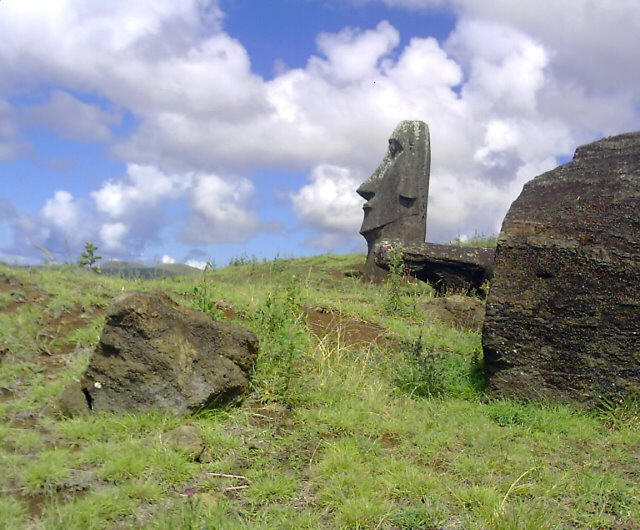
Easter Island: At the Rano Raraku volcano hundreds of both finished and
unfinished moai are located both inside and out of the crater.
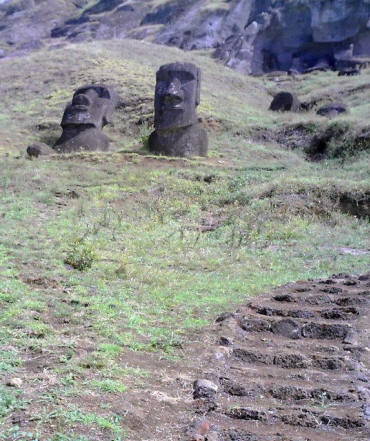
Easter Island: At the Rano Raraku volcano hundreds of both finished and
unfinished moai are located both inside and out of the crater.
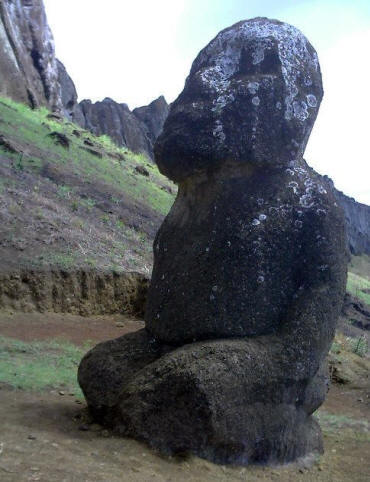
Easter Island: At the Rano Raraku volcano hundreds of both finished and
unfinished moai are located both inside and out of the crater.
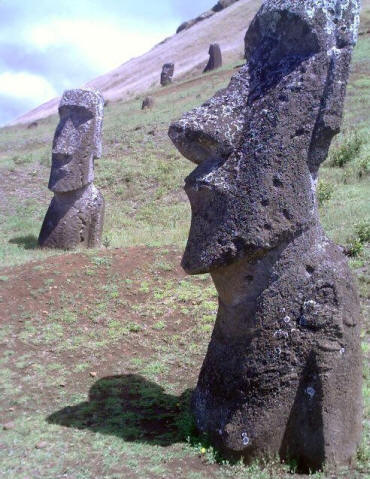
Easter Island: At the Rano Raraku volcano hundreds of both finished and
unfinished moai are located both inside and out of the crater.
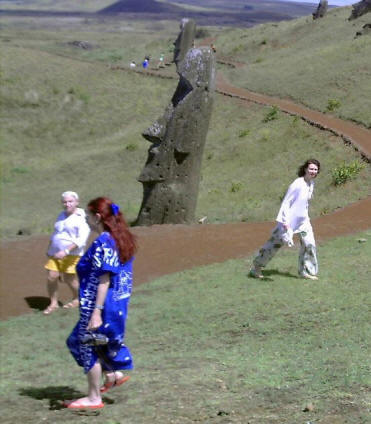
Easter Island: Hundreds of visitors roam the crater to see the both
finished and unfinished moai located there.
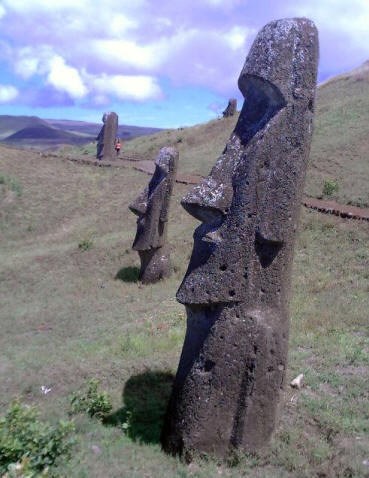
Easter Island: At the Rano Raraku volcano hundreds of both finished and
unfinished moai are located both inside and out of the crater... I know;
when you've seen one you've seen them all!

Easter Island: A well worn path snakes its way through the Rano Raraku
volcano quarry area.

Easter Island: This solitary specimen sits behind its own wall at the
Rano Raraku volcano crater.
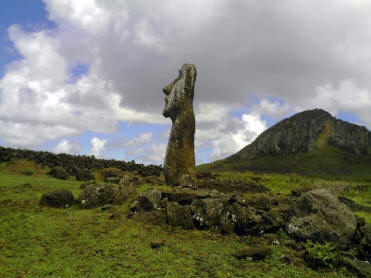
Easter Island: At the Rano Raraku volcano hundreds of both finished and
unfinished moai are located both inside and out of the crater.
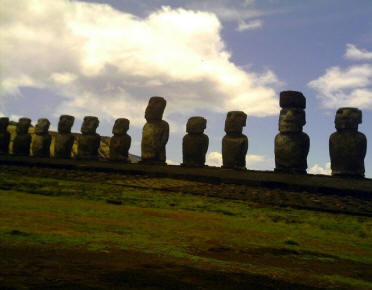
Easter Island: At the Ahu Tongariki location fifteen moai line up for
photos. Some years ago a giant tidal wave knocked many of them down.
Later a major effort got them back in place... minus hats of most.
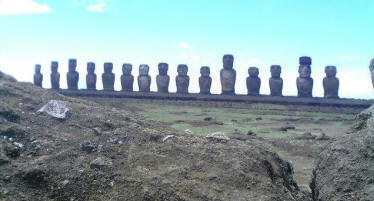
Easter Island: At the Ahu Tongariki location fifteen moai line up for
photos.
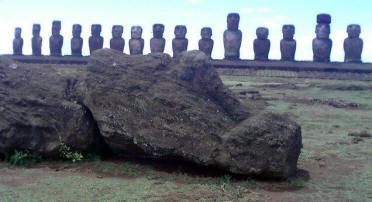
Easter Island: At the Ahu Tongariki location fifteen moai line up for
photos.

Easter Island: At the Ahu Tongariki location. This is the "hat rack,"
recovered topknots waiting to be replaced on the heads of the nearby moais.
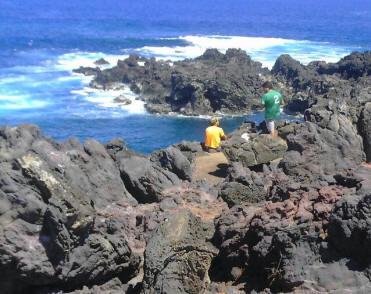
Easter Island: Coastal shoreline along the southwestern end of the
island.
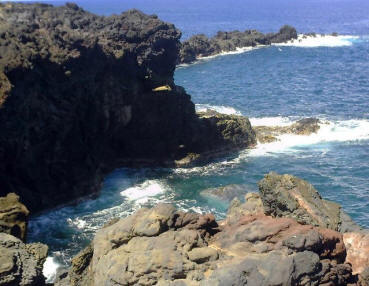
Easter Island: Coastal shoreline along the southwestern end of the
island.
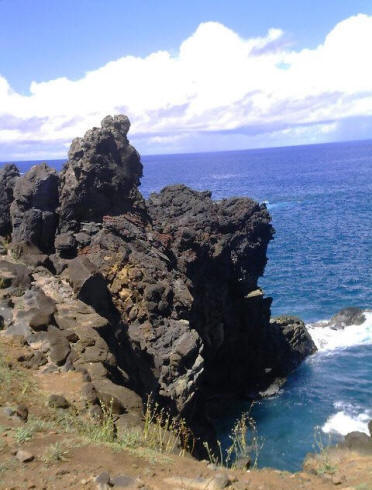
Easter Island: Coastal shoreline along the southwestern end of the
island.
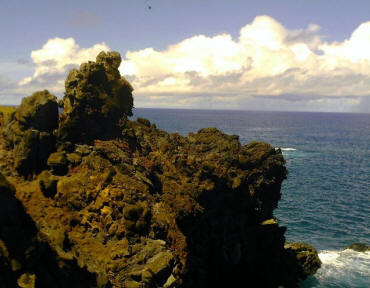
Easter Island: Coastal shoreline along the southwestern end of the
island.
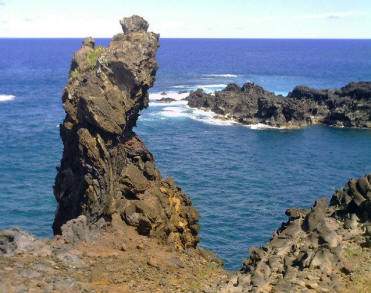
Easter Island: Coastal shoreline along the southwestern end of the
island.
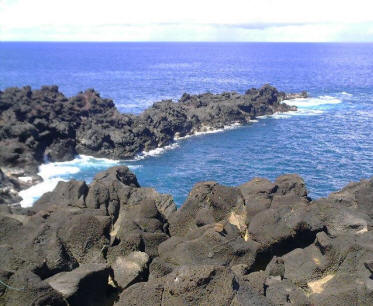
Easter Island: Coastal shoreline along the southwestern end of the
island.

Easter Island: Coastal shoreline along the southwestern end of the
island.
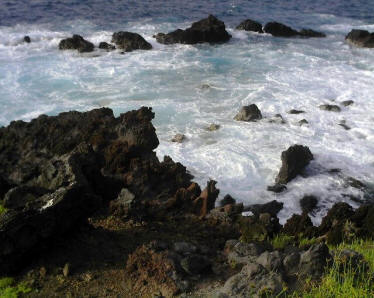
Easter Island: Rugged lava flows create a powerful coastline.
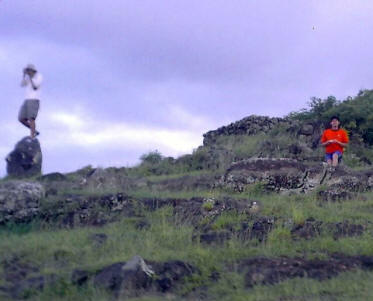
Easter Island: Photographers at sunset snapping the Tahai Moai site, one
of the few completely restored sculptures on the island.
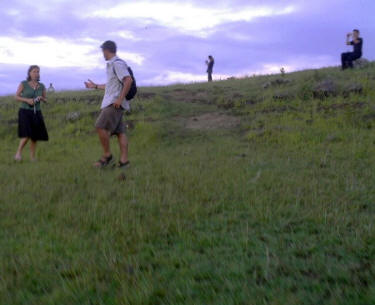
Easter Island: Photographers at sunset snapping photos of the Tahai Moai
site.

Easter Island: A part of the Tahai Moai site at sunset, one of the few
completely restored sculptures on the island.
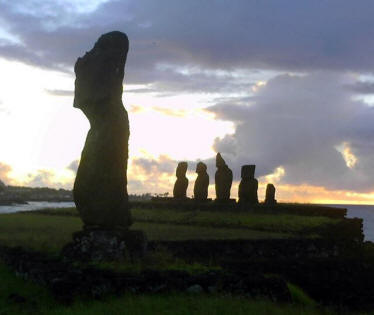
Easter Island: A part of the Tahai Moai site at sunset, one of the few
completely restored sculptures on the island.
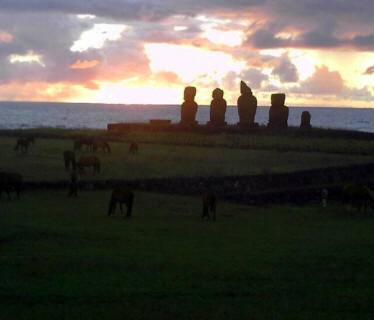
Easter Island: A part of the Tahai Moai site at sunset, one of the few
completely restored sculptures on the island.
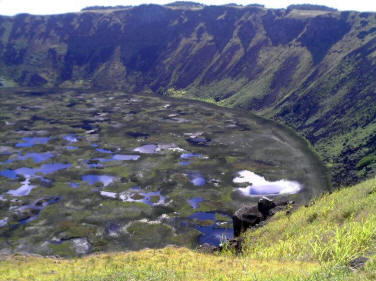
Easter Island: View of the caldera from the Orango ruins on the rim of
an extinct volcano.
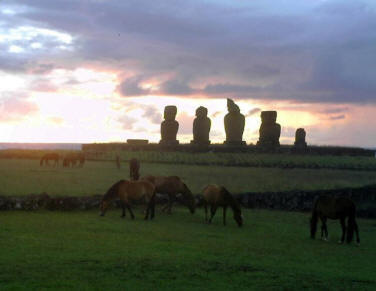
Easter Island: A part of the Tahai Moai site at sunset, one of the few
completely restored sculptures on the island.
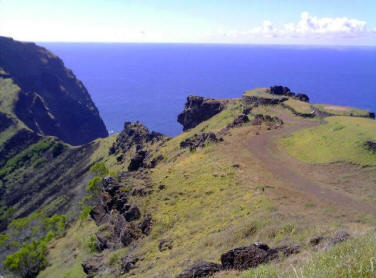
Easter Island: On the rim of the extinct volcano at the Orango ruins.
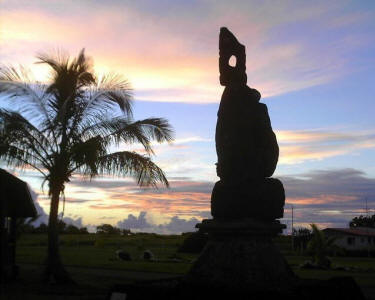
Easter Island: Sculpture on the grounds of the deserted airport at sunset on
my last night there.

Easter Island: Sculpture on the grounds of the deserted airport at sunset on
my last night there. |
 
 6
January 2006 6
January 2006
Happy New Year and hello from Isla de Pascua,
In
the last postcard from Santiago I mentioned my unrealistic hope of being
on the flight to Rapa Nui the day before Christmas. Instead, the last day
of the year I finally left the mainland for the islands. It took a while
to get here and after six days and nights marooned on the island wonder if
I should have skipped the adventure. True, there are a lot of big strange
faced sculptures, but even up close they look just like they do in the
travel photos. Flying in a cramped economy class cabin with every seat
filled and a rambunctious tot practicing his tap dancing lessons on the
back of my seat for the entire five hour endurance test is not my idea of
the way to start a "vacation" in an island paradise, even if it is the
site of an enigmatic archaeological extravaganza.
While the rest of the world knows this place as
Easter Island,
here it is officially called
Isla de Pascua or
Rapa Nui.
Actually, local people on the island sometimes refer to their isolated
volcanic chunk of Polynesia as Te Pito o Te Henua,
meaning "The Center (or Navel) of the World." I'll always think of it from
now on as an excellent example of why I avoid spending a lot of time in
popular tourist destinations. Travelers less burdened by excessive time on
the road might focus on the beautiful and exotic black volcanic formations
that ring the island, or the gorgeous sunsets creating perfect backdrops
for silhouette photos of the 800 or so moai, the signature stone faces
scattered around the island. Others might be lucky enough to encounter
only the warm friendly natives and their genuinely welcoming hospitality.
With a little more luck or professional guidance, they might even find the
very few places offering gourmet quality meals... albeit at prices
inflated 200% from the already high prices on the Chilean mainland. But,
you guessed it; I ended up sampling the full spectrum of hospitality on Rapa Nui and my
experiences included more bitter tastes than sweet. To begin with, the
conveniently located better hotels all have high-season room rates above
$100, even with bargaining... and I could find only four that had any kind
of air-conditioning, something desperately needed on this hot humid dot in
the South Pacific.
Our
flight arrived just before three in the afternoon and a cooling breeze
masked the stifling air. I started my hike as usual, covering most of the
10 by 10 block town layout in a couple hours. My first nighter, the Hotel Taha Tai
offered Motel 6 quality twin-bed rooms with an anemic portable
air-conditioner for $140; bargaining got the room rate down to $100.
Recently constructed, it may be the newest hotel on the island. The
welcoming staff seemed anxious for my business, this being the first day
of the high season, but noted they could only guarantee availability for
four of the six nights I expected to be on the island. After getting
settled in the room I booked a full day tour through the hotel and looked
forward to being shuttled around to the most important archaeological
sites the next day. Then, with the protection of the hotel's umbrella I
went for a stroll. It rains often here, though not for long and the
unpaved roads are rarely muddy. That night I joined other guests in the
hotel to watch a video screening of the 1994 film "Rapa
Nui"
about the overthrowing of the Long Ears tribes by the revolting Short Ears
tribes after all the trees had finally been cut down. The film follows
closely the myths based on oral tradition and archaeological evidence.
One
of the reasons I decided to add Easter Island to my already rich itinerary
is an article about a new book written by Jared Diamond, "Collapse:
How Societies Choose To Fail Or Succeed,"
sent to me by David Hopper shortly before I left six months ago. Another
friend, Marsha completely independently alerted me to the same book as I
neared this part of Chile. In the book Diamond examines several extinct
cultures that have failed including those on Easter Island. I am looking
forward to reading it when I return.
As
the 10AM departure time for my tour approached the next morning, I waited
in the lobby for my ride. An incongruous gathering of staff around the
simple reception desk kept glancing my way. None could speak English, but
finally one approached me and announced "tour impossible." The tour had
been over sold; alternatives were suggested, but in my irritated state
nothing sounded appealing. Finally, I told them I'd make other
arrangements later and left the hotel to see what serendipity might have
to offer besides more blisters. Speaking of blisters, there seems to be an
epidemic of the things on my feet. As soon as one heals, another pops up.
This time my search for alternative accommodations ranged further from
the town "center." I should note there really is no town "center," just
one ten block long main street along which the few businesses are
clustered. The street starts at the end of the airport runway and and
takes off in a perpendicular direction that parallels the coastline over a
few blocks to the northwest. Long stretches of the paved road look
deserted. Here and there one sees a few nondescript hostels or
guesthouses, though none looked terribly appealing at first glance. The
fancy places tended to be on the bluffs above the south-western shoreline
around the periphery of the main inhabited part of the island.
Combining my hike of exploration with hotel shopping, quite some distance
from "town" I found the
Cabins Pikera Uri about a block from the island's only museum
and sitting at the edge of a pasture facing west and overlooking the
water. Bareback riders herded both horses and cattle into the adjacent
pasture early each morning. For two days I awoke to the duet of a cock's
crow and a horse's whinny outside my screened windows. There is a distinct
difference in the sound of a rooster crowing here and in America; I must
assume they crow in Spanish! At $40 cash the simple cottage looked like a
good compromise for a couple nights. Two groups of sculptured rocks with
the stony stares stood on the bluffs within walking distance. The area
faced west and provided a good view of the sunset skies around 9PM each
evening.
Being so far out of town meant I'd need to use the taxicabs into and out
of town... or walk. Cabing from town turned out to be easy and cheap; $2
per trip. But, cabs rarely visited the museum area near my rural hotel, so
getting into town always meant a half hour hike whether I felt up to it or
not. After two nights this got old and I switched to another place not far
from the entrance to the airport, the Manatara Hotel. Run
by a truly delightful third generation Rapa Nuin extended family, this $50
place turned out to be one of the best values on the island. The pool area
swarmed with excited children splashing and laughing. A year old baby
learning to walk and swim delighted everyone with his antics, keeping the
older children occupied for hours and guests amused in the process. Mito,
the charming owner cooks gourmet meals for guests with advance
reservations. At $24 my meals, fish one night and steak the other, served
on the patio under a flower covered arbor bathed in cool breezes are
clearly highlights of my visit to this island of stony faces. Meals in
other restaurants and fast food stands frequently exposed me to surly,
lackadaisical service people and mediocre food poorly prepared.
In
addition to hotel meals, everything costs a whole lot more than back on
the mainland. A small bottle of mineral water is $1.20, the large is $3. A
can of soft drink is $1.10 to $4.40! There is nothing like a supermarket
on the island. Several places claim to be "super Mercados," but all of
those I inspected looked like the general stores of a bi-gone era in rural
America. Internet access is $6 per hour in the sole cyber cafe with a
broadband connection and I counted only five places offering any sort of
Internet access on the entire island. Short cab rides around town are $2,
but rides out to the popular archaeological sites 6 and 9 miles from town
cost $20 each. On one such ride I visited the Rano Raraku region where
most of the huge blocks of volcanic stone were quarried. Actually, the
moai
statues were carved in place as several unfinished works in the quarry
attested. On another I visited the extinct volcano in the Orango area
where the Bird man rituals were performed and saw the three small islands
just off the coast of Rapa Nui. The legend says the island's ecology fell
apart after all the trees had been cut down to support the statue
building. Today there are areas with healthy stands of old trees. However,
most of the island is bare save for sparse coverings of grasses. Hundreds
of horses and cattle freely roam the open ranges with the government
keeping an eye on the individual and collective health of the animals,
freely providing veterinarian services when needed.
Teenagers show off by racing their horses, motorcycles and cars as fast as
they will go through neighborhood streets, especially when passing
slowly strolling foreign tourists. Twice dilapidated cars full of
high-school age boys stopped and offered syrup sweet and insincere
greetings, taunting and laughing as they raced away. A girl sharing my
lunch table one day told me she plans on going to America one day. Now
currently attending a college on the island of 4000 permanent residents
she will transfer to a university in Santiago shortly. Her big dream is to
marry an American! I took a lot of photographs as usual.
Until the next postcard,
Peace
Fred L Bellomy
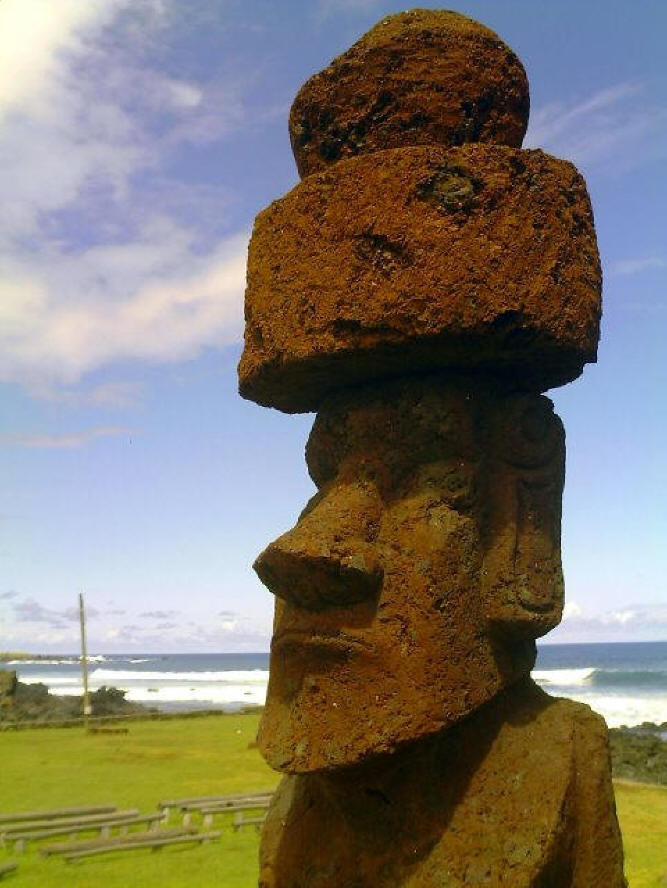
Easter Island: Head shot of the Tahai
Moai, one of the few completely restored sculptures on the island. This
is what everyone comes to Easter Island to see.
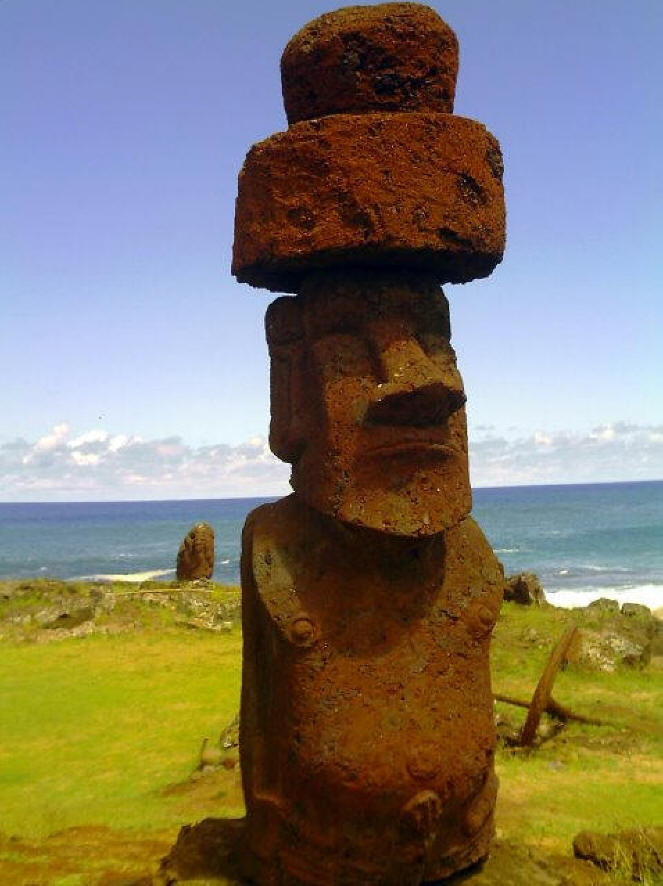
Easter Island: Portrait view of the Tahai
Moai, one of the few completely restored sculptures on the island.

Easter Island: The Tahai Moai, one of the
few completely restored sculptures on the island.
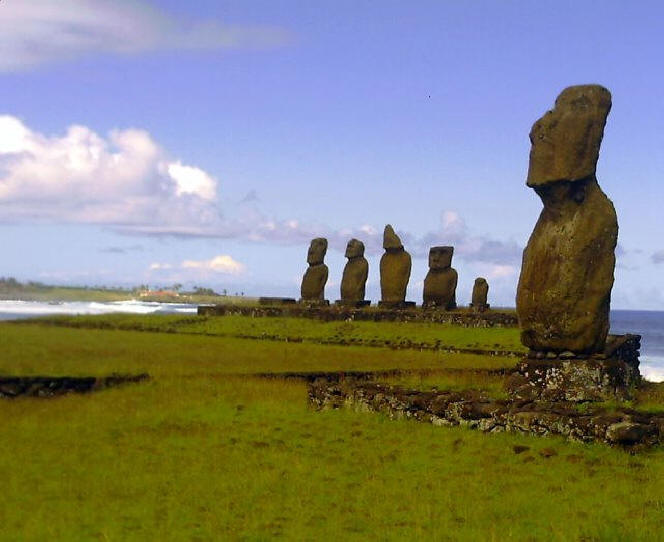
Easter Island: The Tahai Moai area is the site of this group of badly
weathered statues.

Easter Island: The Tahai Moai to the right, one of the undamaged
sculptures on the island.

Easter Island: Along the bluffs near my first hotel I found this strange
sculpture, of recent design I imagine.
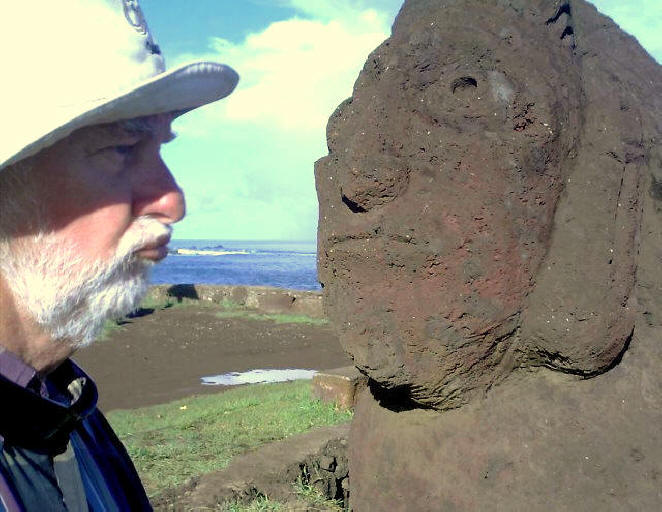
Easter Island: Sculpture on the beach near my first hotel, the $100 Taha
Tai. Who you frowning at?
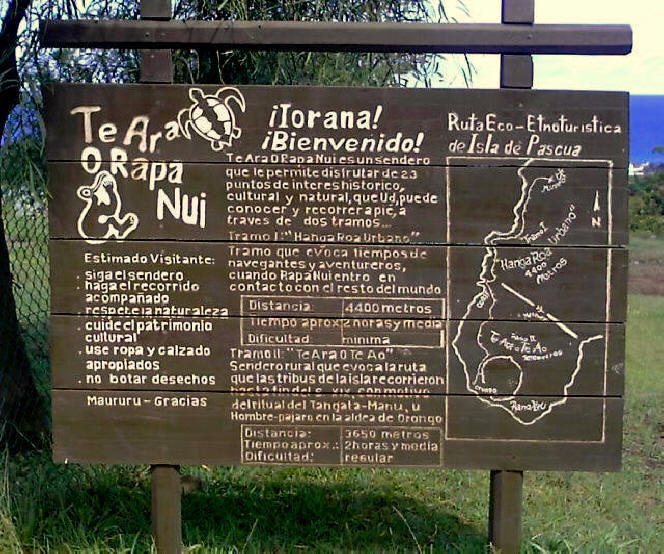
Easter Island: Sign near the tiny museum. My second hotel is located
about a block down the dirt road toward the sea.

Easter Island: Sign near the entrance to the Airport.
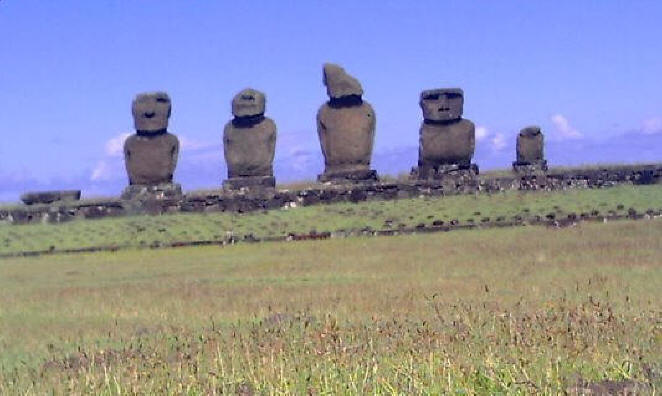
Easter Island: This group of five stand near the Tahai Moai, one of the
few completely restored sculptures on the island.
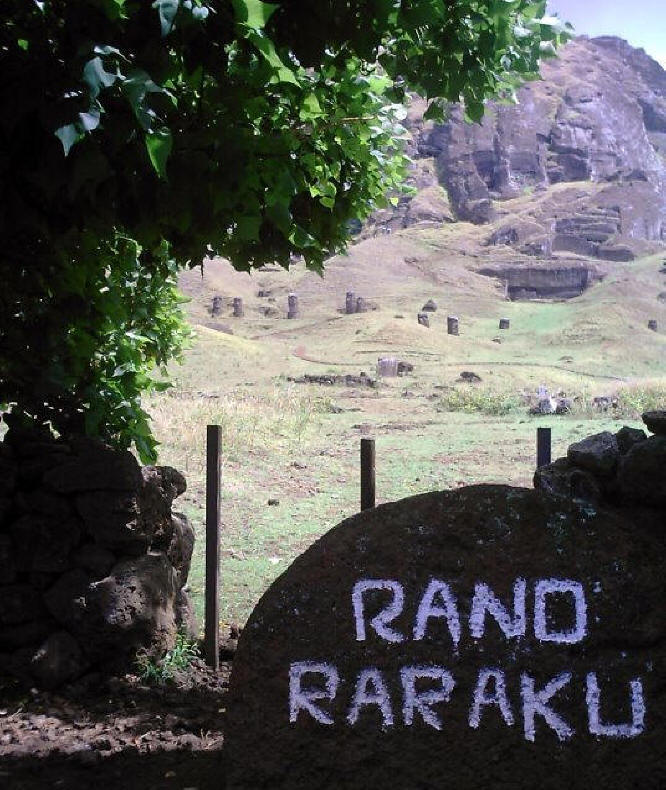
Easter Island: At the Rano Raraku volcano hundreds of both finished and
unfinished moai are located both inside and out of the crater.
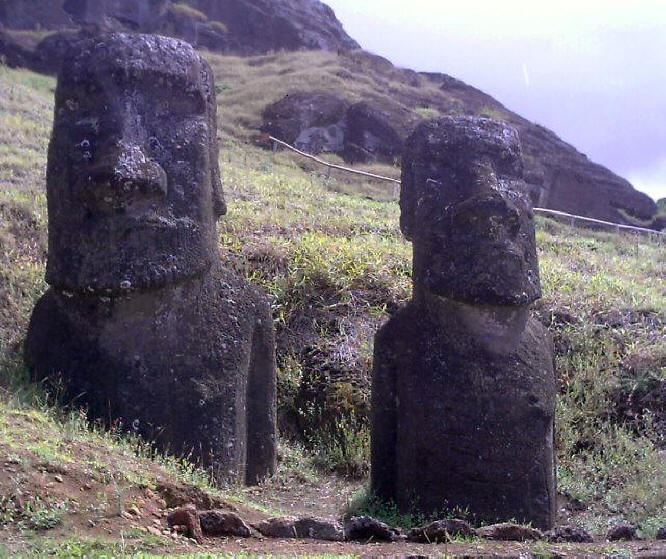
Easter Island: Two nearly completed moai at the Rano Raraku volcano
crater.
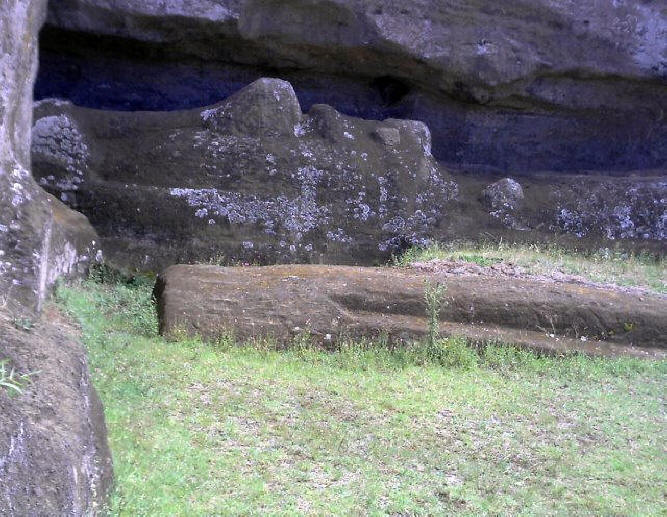
Easter Island: At the Rano Raraku volcano this giant unfinished moai
remains for eternity stuck in the rock.

Easter Island: At the Ahu Tongariki location fifteen moai line up for
photos.
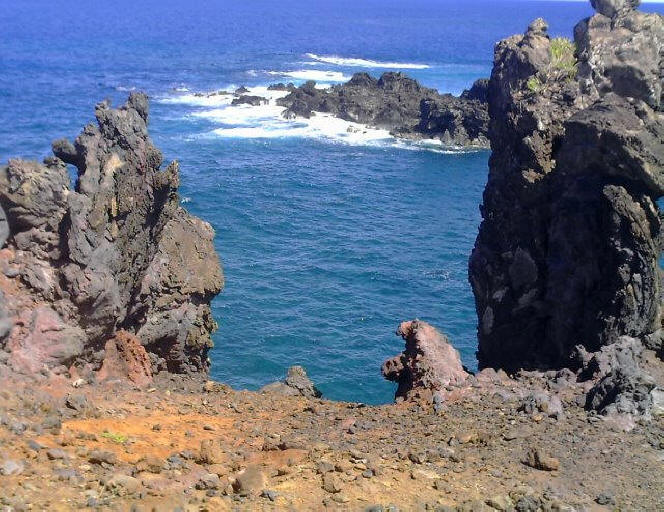
Easter Island: Coastal shoreline along
the southwestern end of the island.
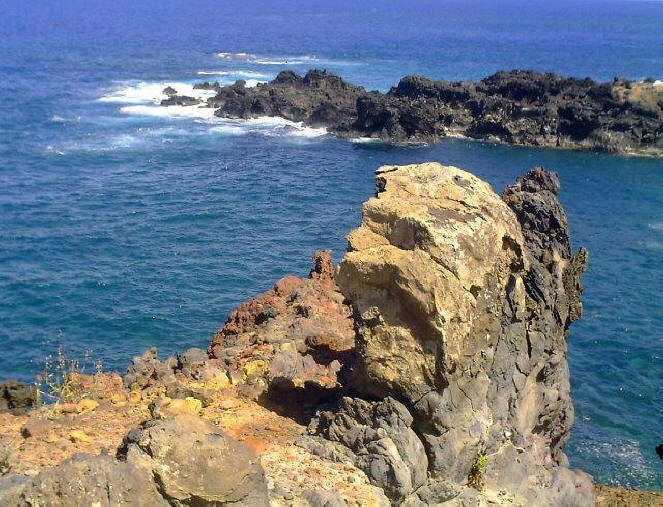
Easter Island: Coastal shoreline along the southwestern end of the
island.

Easter Island: A part of the Tahai Moai site at sunset. The ground cover
is really this bright yellow.
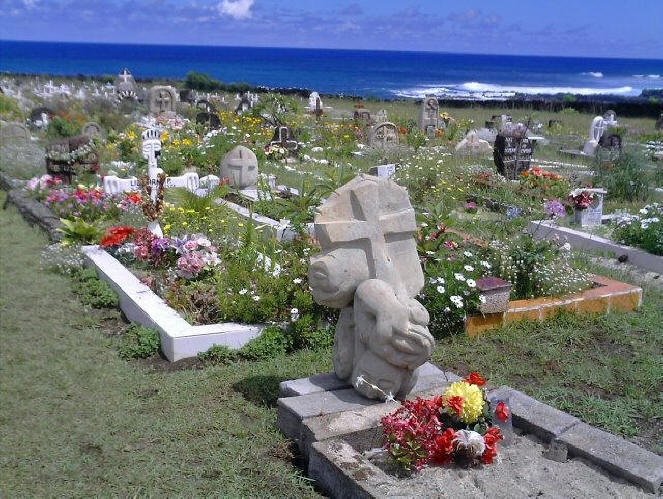
Easter Island: Cemetery. Even on Rapa Nui people die and this is the
final resting place.
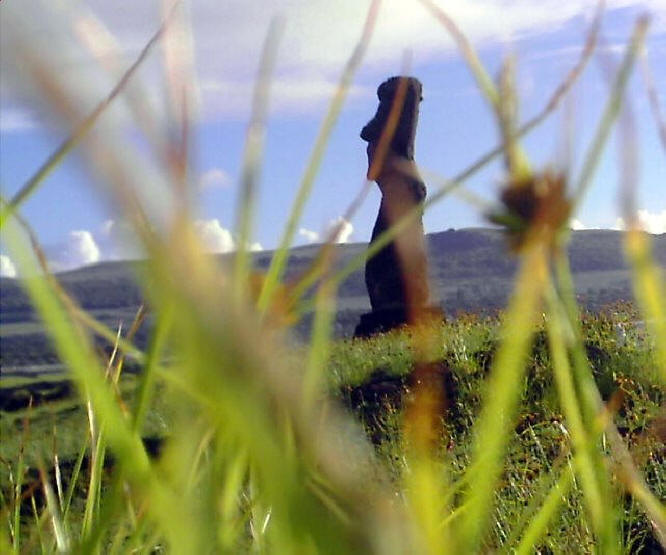
Easter Island: A part of the Tahai Moai site at sunset. The ground cover
is really this bright yellow.
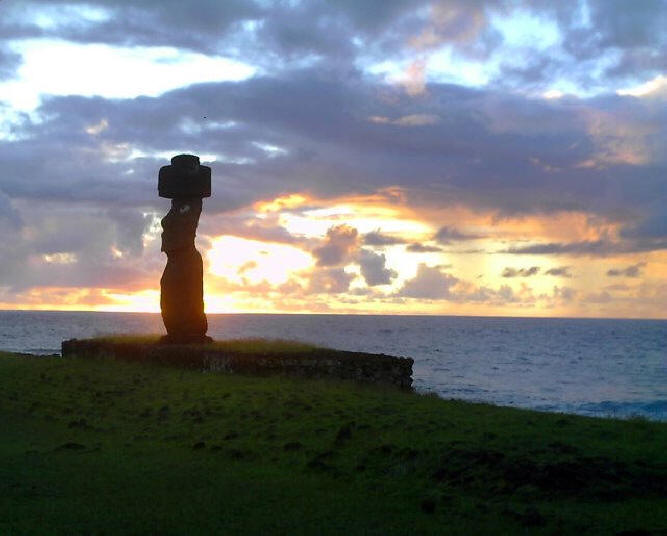
Easter Island: A part of the Tahai Moai site at sunset, one of the few
completely restored sculptures on the island.
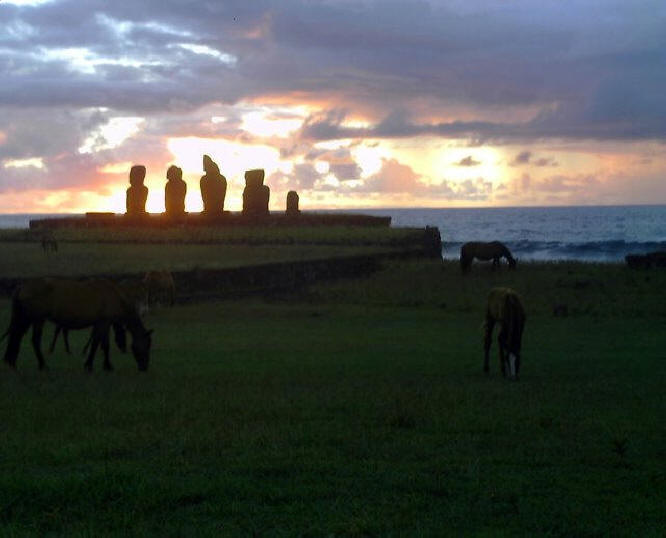
Easter Island: A part of the Tahai Moai site at sunset, one of the few
completely restored sculptures on the island.

Easter Island: Horses graze in the meadow next to my second hotel and near a part of the Tahai Moai
site.
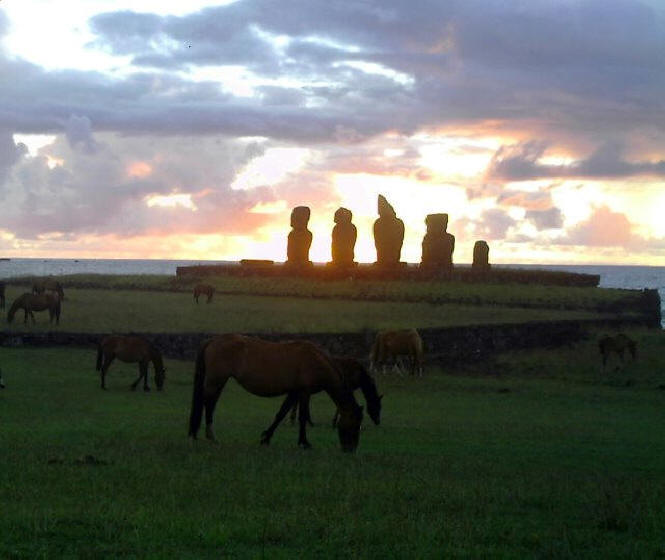
Easter Island: Horses grazing in the meadow near the Tahai Moai site at
sunset.
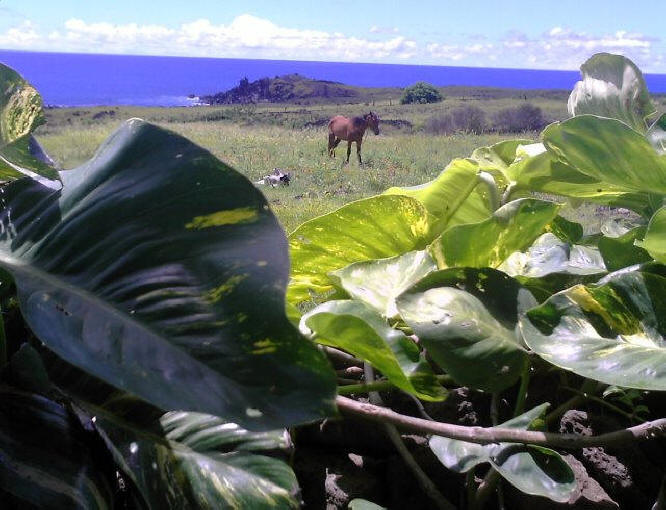
Easter Island: View from my room in the $40 cash Cabins Pikera Uri, the
place I chose for my third and forth nights.
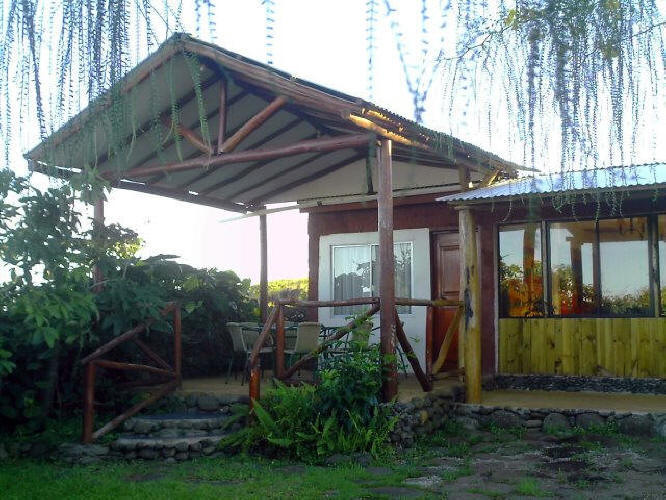
Easter Island: My cabin in the $40 cash Cabins Pikera Uri, the place I
chose for my third and forth nights.
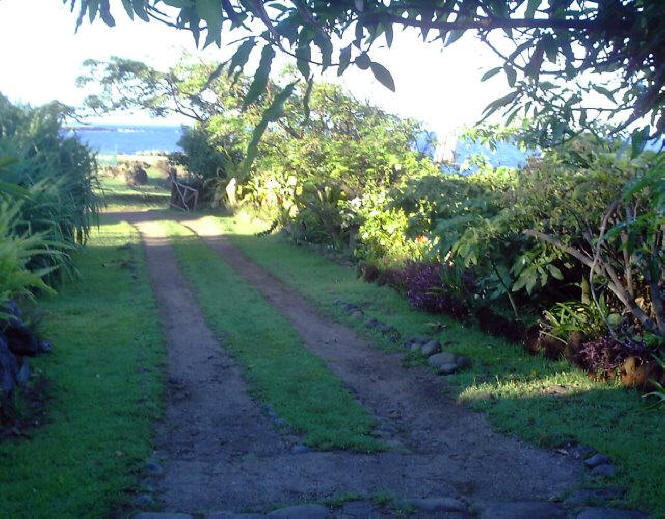
Easter Island: Driveway up to the $40 cash Cabins Pikera Uri, the place
I chose for my third and forth nights.
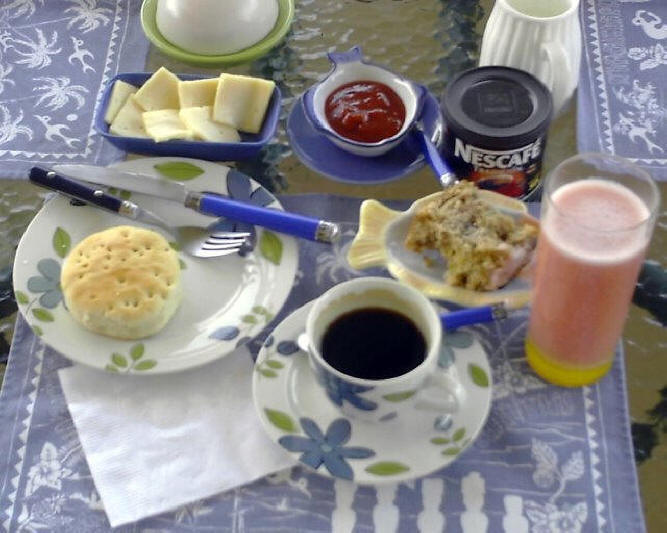
Easter Island: Breakfast at the $40 cash Cabins Pikera Uri, the place I
chose for my third and forth nights.
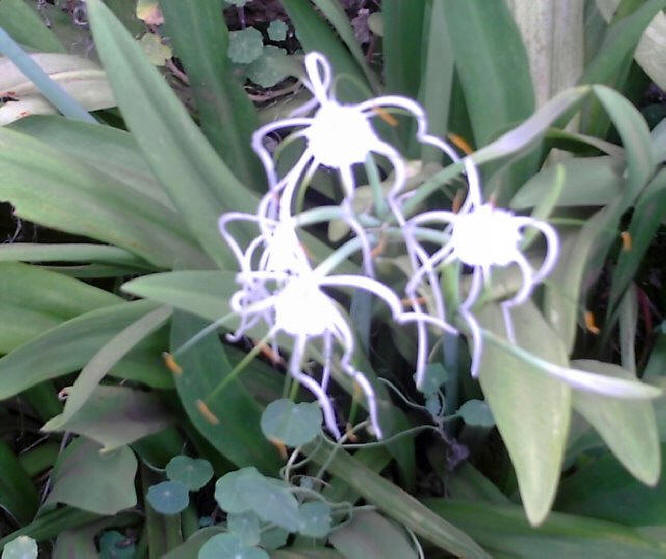
Easter Island: Strange flowers on the grounds of the $40 cash Cabins
Pikera Uri, the place I chose for my third and forth nights.

Easter Island: Sign marking the entrance
to the $50 Manatara Hotel where I spent my last two nights before
returning to Santiago.
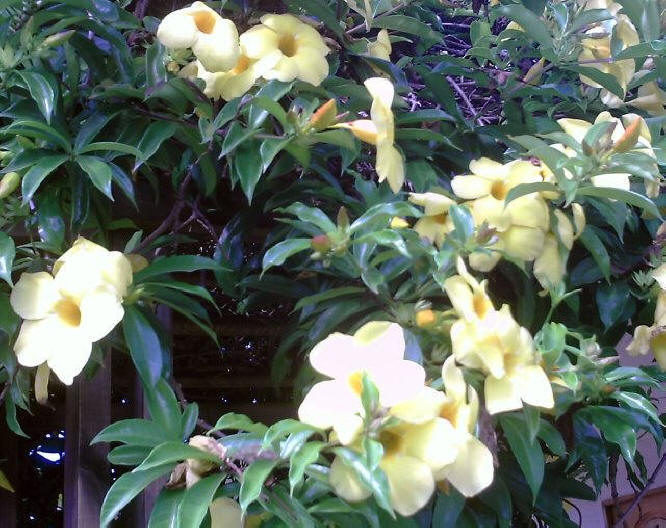
Easter Island: Flowers on the grounds of the $50 Manatara Hotel where I
spent my last two nights before returning to Santiago.

Easter Island: Flowers on the grounds of the $50 Manatara Hotel where I
spent my last two nights before returning to Santiago.

Easter Island: Sign marking the entrance to the Orango ruins, an extinct
volcano with a village used for religious events.
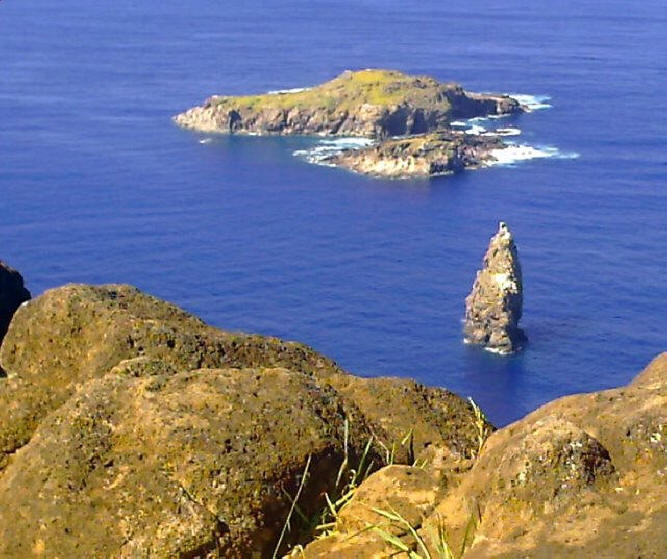
Easter Island: Islands off the southern shores of the islands near the
Orango ruins on the rim of an extinct volcano with a village used for
religious events.
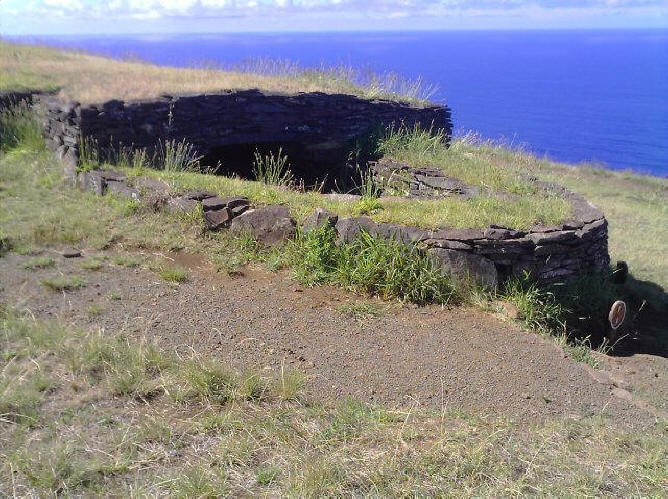
Easter Island: Ruins of dwellings at the Orango ruins on the rim of an
extinct volcano.
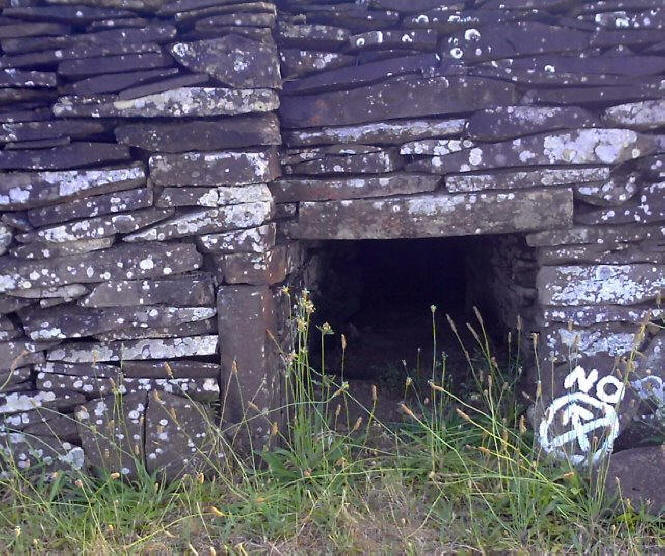
Easter Island: Ruins of dwellings at the Orango ruins on the rim of an
extinct volcano.
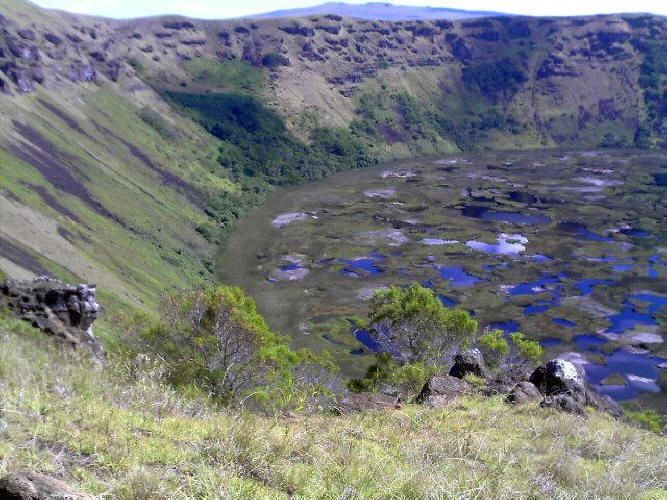
Easter Island: Looking down into the extinct volcano at the Orango
ruins. I have no idea how deep is the water. However, those are reed
plants covering much of the surface.
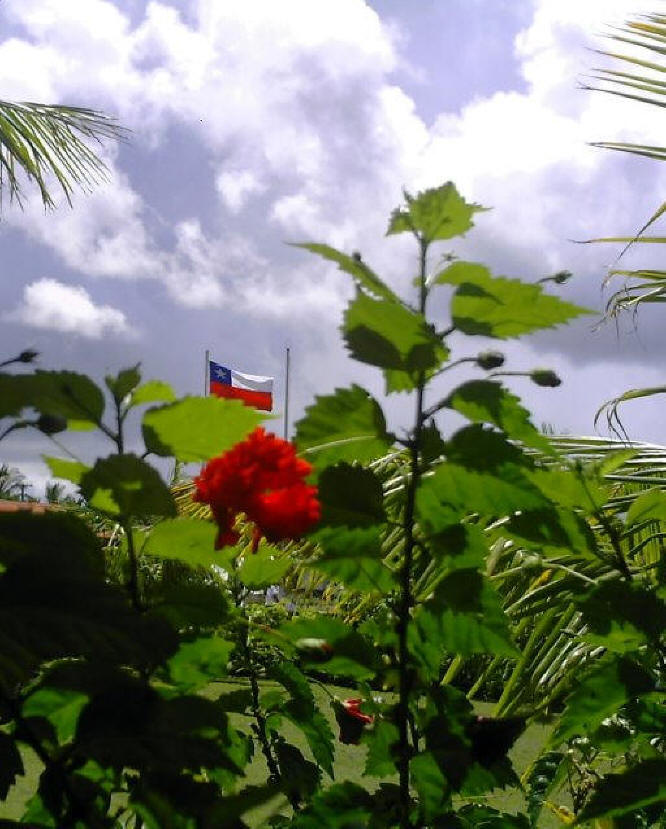
Easter Island: The Chilean national flag flies at
the airport.
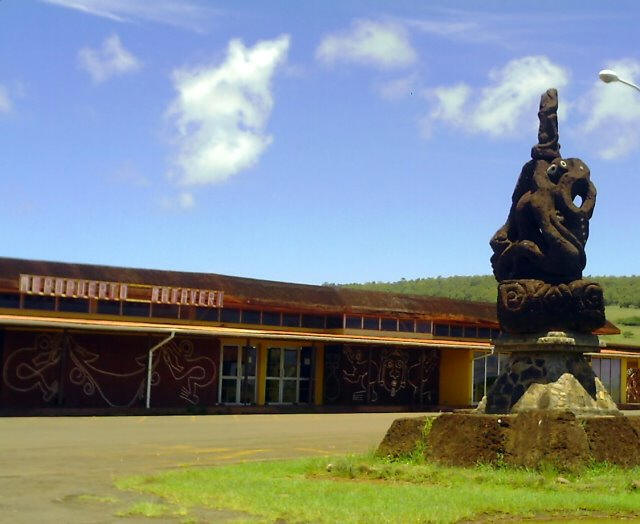
Easter Island: The airport is deserted except during the time when the
few flights arrive and depart several times each week.
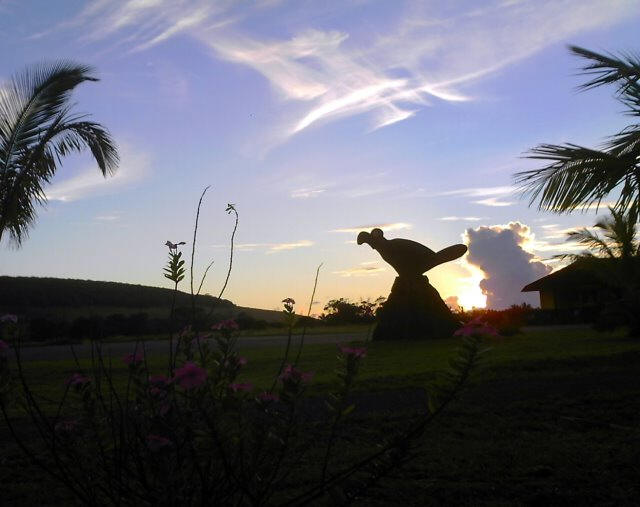
Easter Island: Sculpture on the grounds of the deserted airport at
sunset on my last night there.

Easter Island: Sculpture on the grounds of the deserted airport at sunset on
my last night there.
|
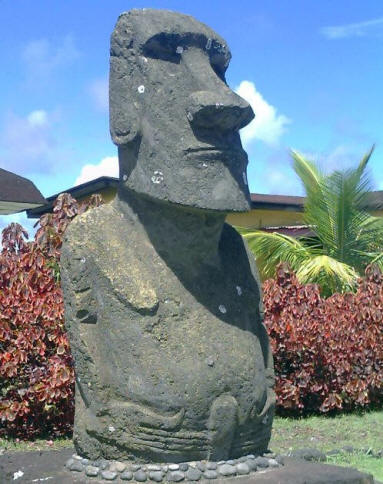
Easter Island: .. or Isla de Pascua or Rapa
Nui. One of the ancient Moai sculptures transplanted to the grounds of the
airport.
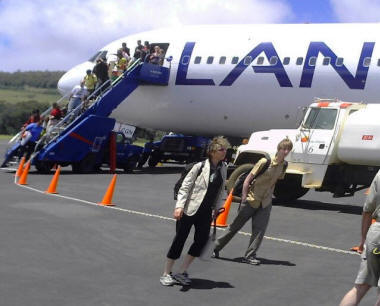
Easter Island: .. or Isla de Pascua or Rapa Nui. Here are the other
passengers dashing for the arrival lobby after we reached the island.

Easter Island: .. or Isla de Pascua or Rapa Nui. Here are the other
passengers dashing for the arrival lobby after we reached the island.

Easter Island: Greeters and touts waiting
for passengers to arrive at the Airport.
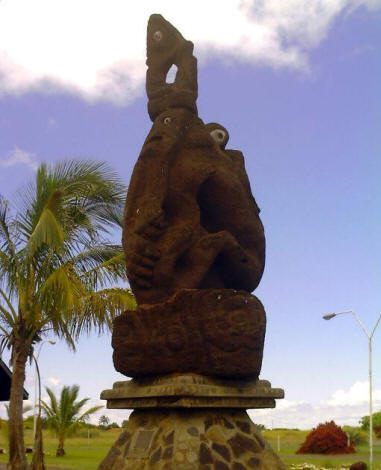
Easter Island: Modern sculpture at the entrance to the airport.

Easter Island: Modern sculpture on the grounds of the airport the day I
left.

Easter Island: "Modern" sculpture at the entrance to the airport.
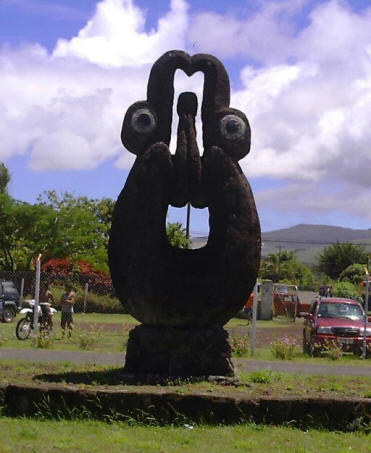
Easter Island: Sculpture near the entrance to the Airport.
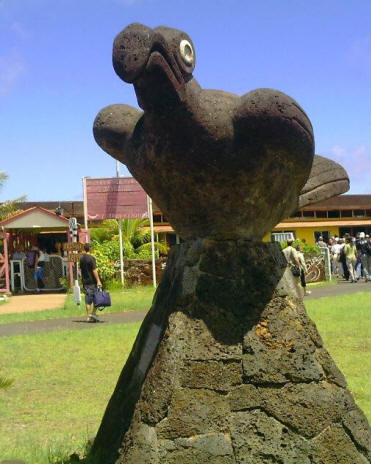
Easter Island: Sculpture near the entrance to the Airport.

Easter Island: Sign near the entrance to the Airport.
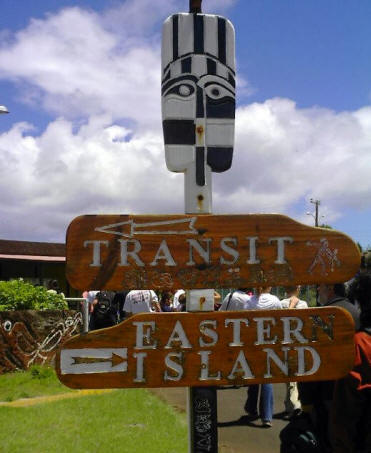
Easter Island: Sign near the entrance to the Airport.

Easter Island: The Tahai Moai, one of the few completely restored sculptures
on the island.
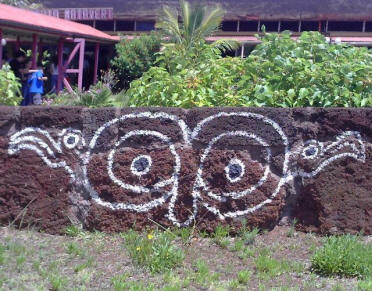
Easter Island: Wall decorations near the entrance to the Airport.
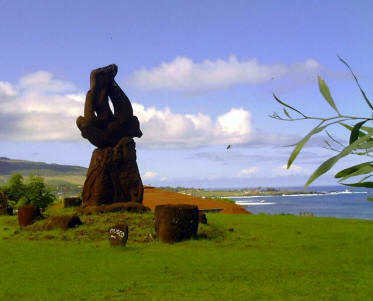
Easter Island: Near the Tahai Moai next to the museum.

Easter Island: The Tahai Moai, one of the undamaged sculptures on the
island.
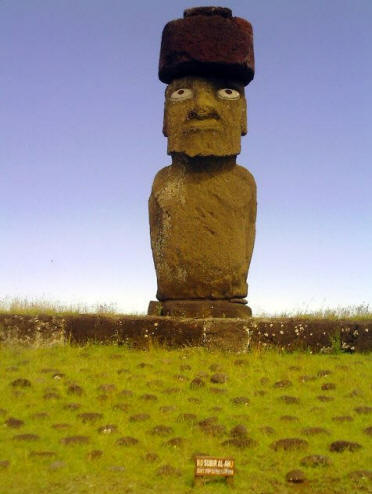
Easter Island: The Tahai Moai, one of the few completely restored sculptures
on the island.

Easter Island: Another shot from a different angle of the Tahai Moai, one of
the few completely restored sculptures on the island.
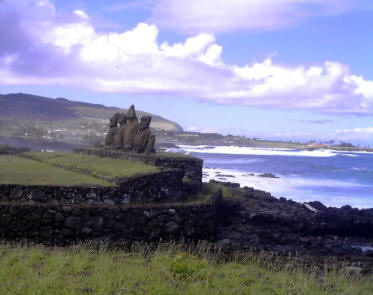
Easter Island: The Tahai Moai area is the site of this group of badly
weathered statues.

Easter Island: The Tahai Moai stands in the background, one of the few
completely restored sculptures on the island.
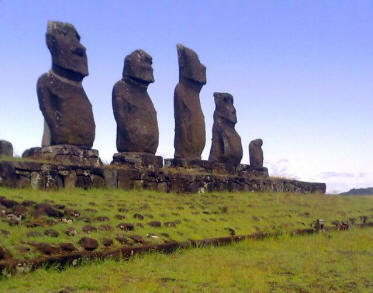
Easter Island: This group of five badly weathered moai stand near the
completely restored Tahai Moai out of view to the right.
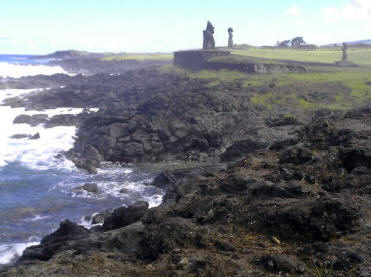
Easter Island: On the rocky western shoreline stand the Tahai Moai group,
not more than a ten minute walk from the second place I stayed.
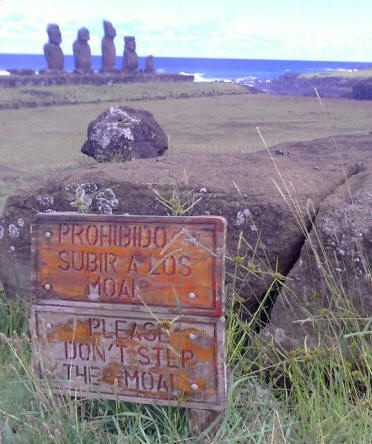
Easter Island: On the rocky western shoreline stand the Tahai Moai group,
not more than a ten minute walk from the second place I stayed.
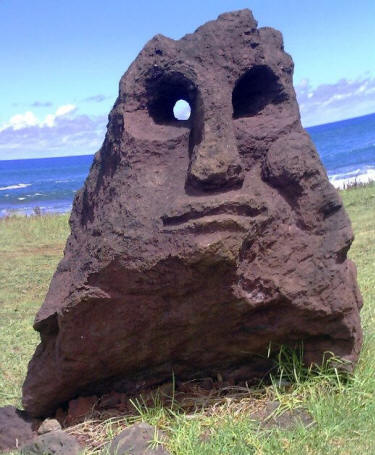
Easter Island: Along the bluffs near my first hotel I found this strange
sculpture frowning at me. It is of recent design I imagine.
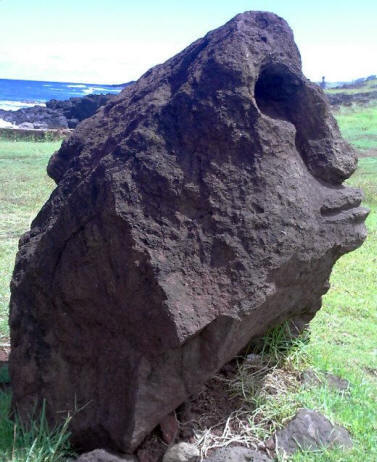
Easter Island: Profile of this strange sculpture.
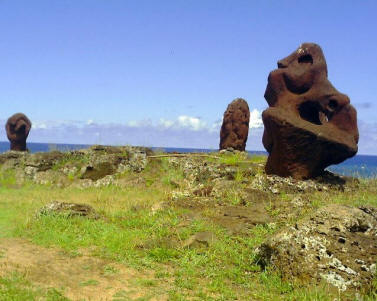
Easter Island: Along the bluffs near my first hotel I found these strange
sculptures, of recent design I imagine.
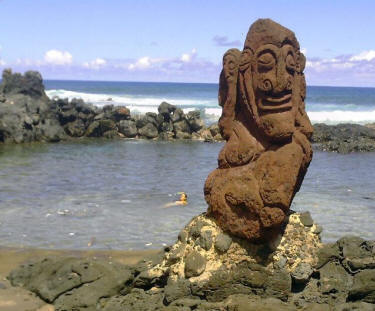
Easter Island: This seems to be a sculpture by a modern artist trying to
emulate the ancients.

Easter Island: A modern sculpture on the beach. I wonder where the artist
found a subject so ugly?
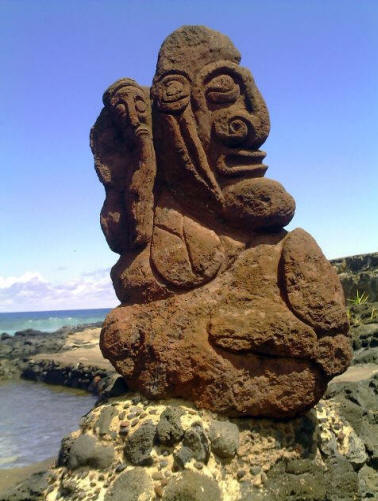
Easter Island: A modern sculpture on the beach. Hmm. the main guy doesn't
look so crooked in this profile view, but look at that sad face off to the
left.
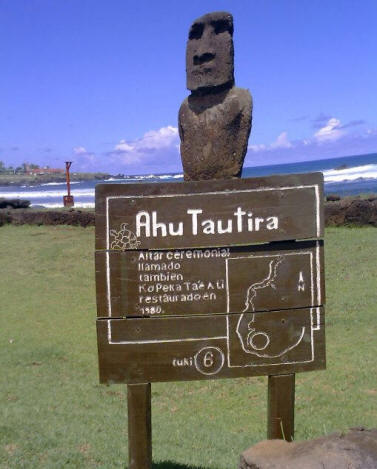
Easter Island: Ahu Tautira, badly weathered.

Easter Island: Ahu Tautira, badly weathered.
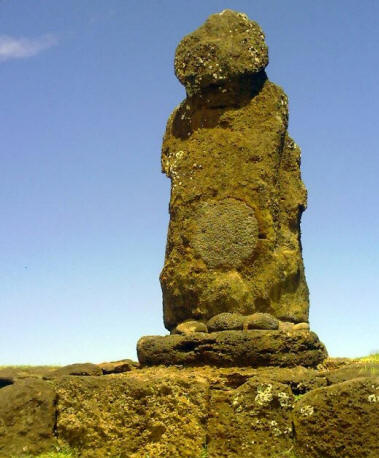
Easter Island: The back side of Ahu Tautira, badly weathered.
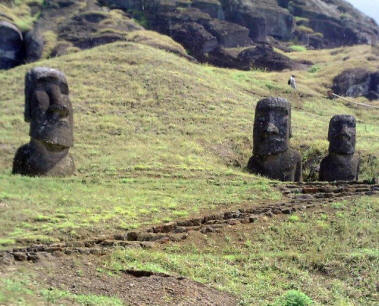
Easter Island: At the Rano Raraku volcano hundreds of both finished and
unfinished moai are located both inside and out of the crater.
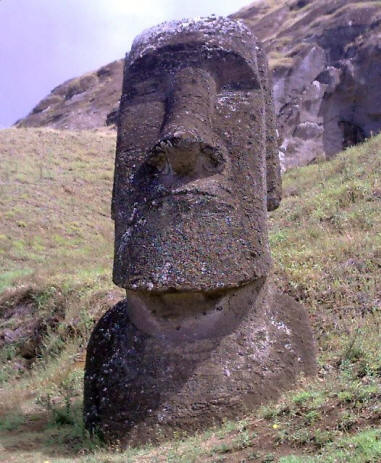
Easter Island: A nearly completed moai at the Rano Raraku volcano crater.
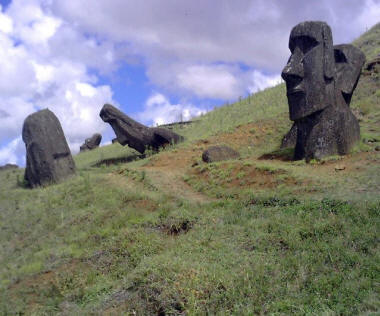
Easter Island: Hundreds of both finished and unfinished moai are located
both inside and out of the crater.
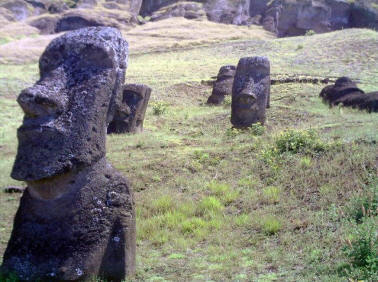
Easter Island: At the Rano Raraku volcano hundreds of both finished and
unfinished moai are located both inside and out of the crater.

Easter Island: Iconic moai located inside the crater. This is the one often
seen with stories about Easter Island.
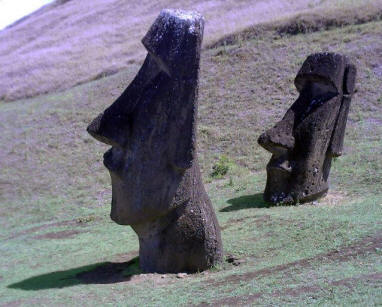
Easter Island: At the Rano Raraku volcano hundreds of both finished and
unfinished moai are located both inside and out of the crater.
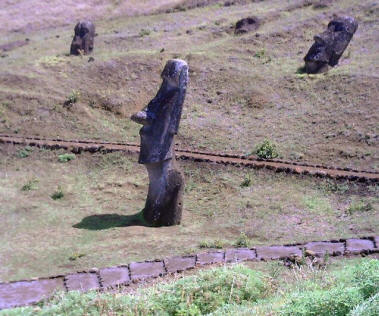
Easter Island: At the Rano Raraku volcano hundreds of both finished and
unfinished moai are located both inside and out of the crater.
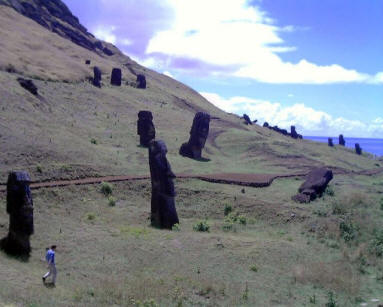
Easter Island: At the Rano Raraku volcano hundreds of both finished and
unfinished moai are located both inside and out of the crater.
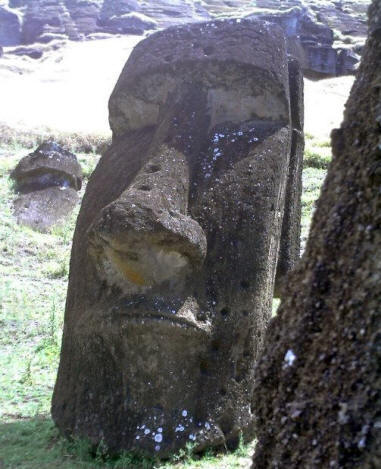
Easter Island: At the Rano Raraku volcano hundreds of both finished and
unfinished moai are located both inside and out of the crater.

Easter Island: This group has its own pedestal at the Rano Raraku volcano
crater.
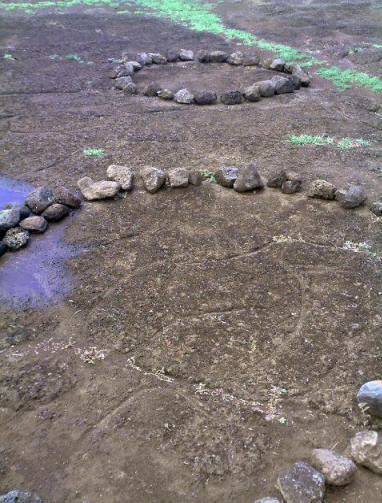
Easter Island: Near the Ahu Tongariki location is found this petroglyph.
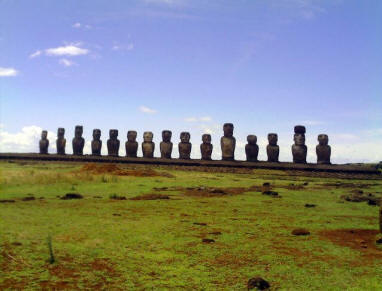
Easter Island: At the Ahu Tongariki location fifteen moai line up for
photos.
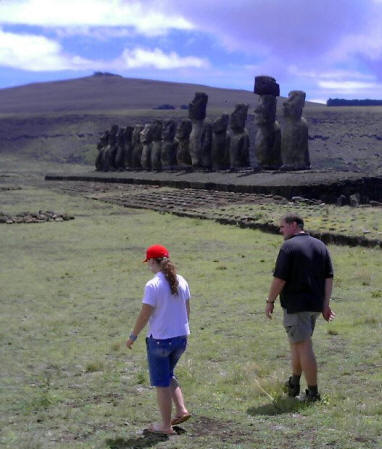
Easter Island: Tourists wander freely about the Ahu Tongariki location.
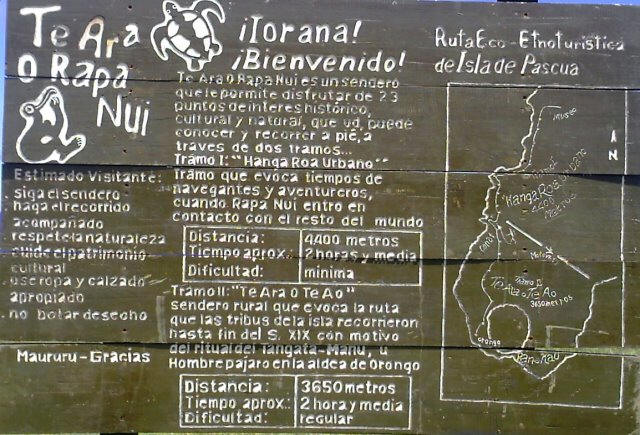
Easter Island: Sign discusses 3.6km hiking trail to south western end of
island where the extinct volcano is located.

Easter Island: Sculpture in a small park at the end of the main street...
the father of his country? I don't know.
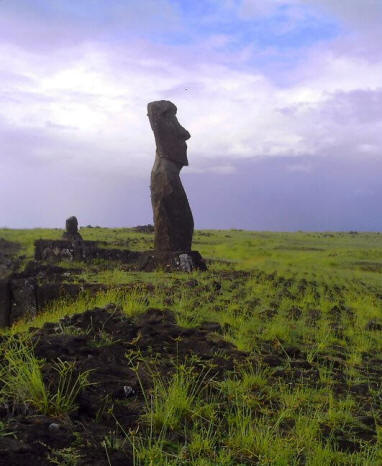
Easter Island: A part of the Tahai Moai site at sunset.
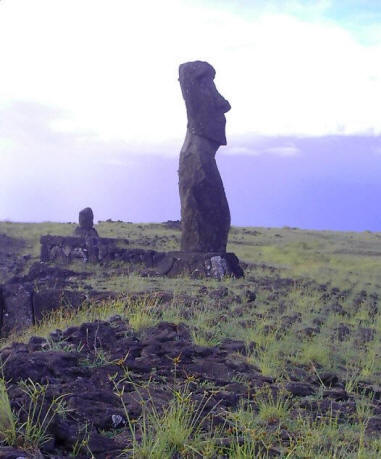
Easter Island: A part of the Tahai Moai site at sunset.
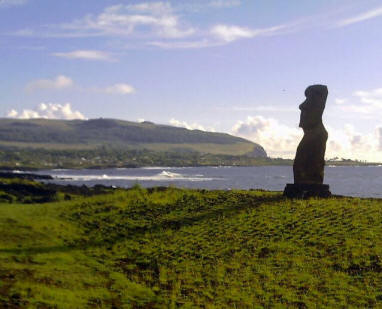
Easter Island: A part of the Tahai Moai site at sunset.
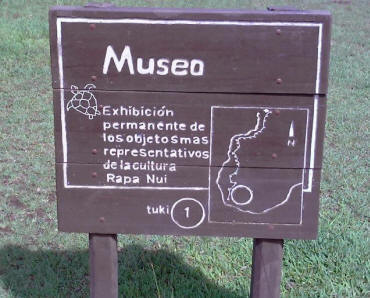
Easter Island: Sign in front of the tiny museum. My second hotel is located
about a block down the dirt road toward the sea.
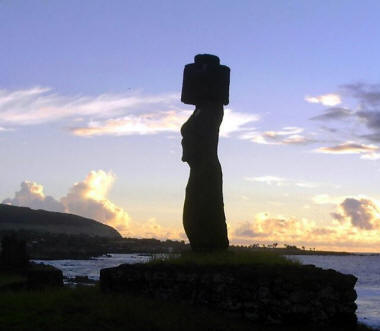
Easter Island: The Tahai Moai at sunset, one of the few completely restored
sculptures on the island.
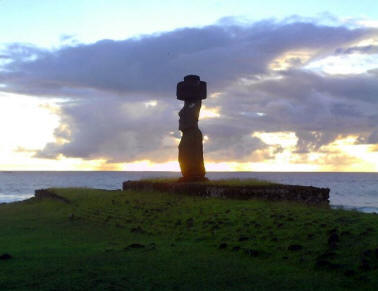
Easter Island: The Tahai Moai at sunset, one of the few completely restored
sculptures on the island.
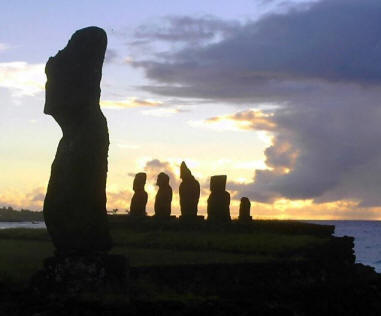
Easter Island: A part of the Tahai Moai site at sunset, one of the few
completely restored sculptures on the island.
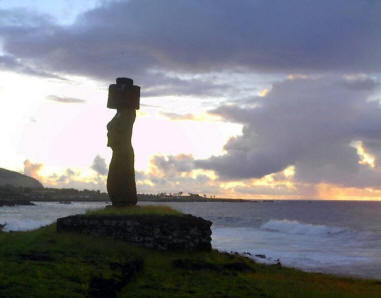
Easter Island: A part of the Tahai Moai site at sunset, one of the few
completely restored sculptures on the island.
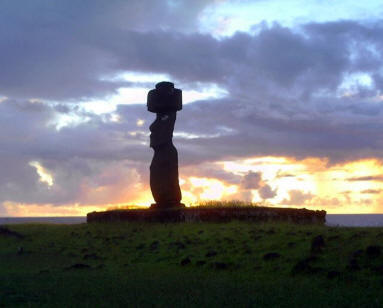
Easter Island: A part of the Tahai Moai site at sunset, one of the few
completely restored sculptures on the island.
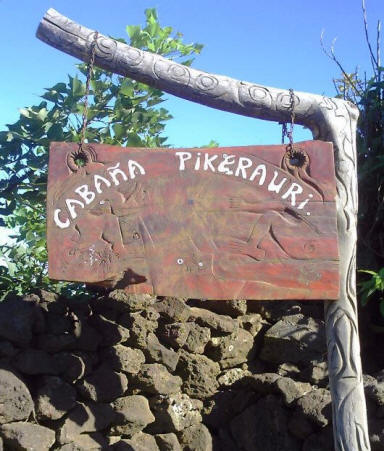
Easter Island: Sign marking the entrance to the $40 cash Cabins Pikera Uri,
the place I chose for my third and forth nights.
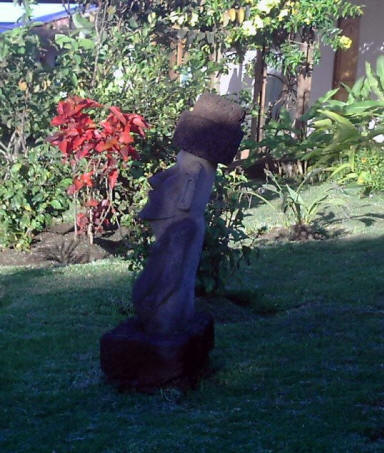
Easter Island: Flowers on the grounds of the $50 Manatara Hotel where I
spent my last two nights before returning to Santiago.
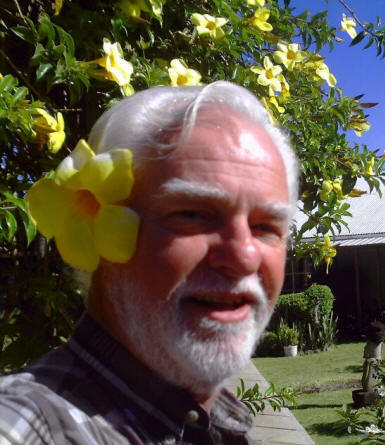
Easter Island: Flowers on the grounds of the $50 Manatara Hotel where I
spent my last two nights before returning to Santiago. Oops, looks like
my ear got tangled up with one of the flowers.
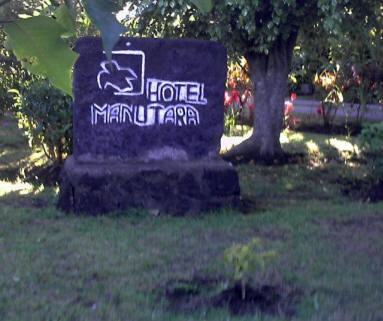
Easter Island: Plantings on the grounds of the $50 Manatara Hotel where I
spent my last two nights before returning to Santiago.
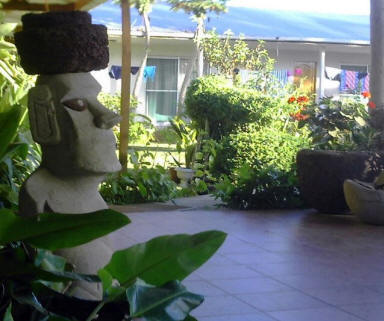
Easter Island: Lobby patio at the $50 Manatara Hotel where I spent my last
two nights before returning to Santiago.
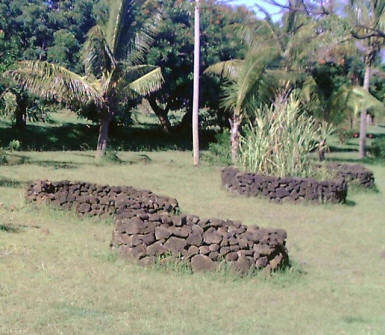
Easter Island: On the way to Orongo we passed this example of a unique
technique used by the ancient people to grow crops.
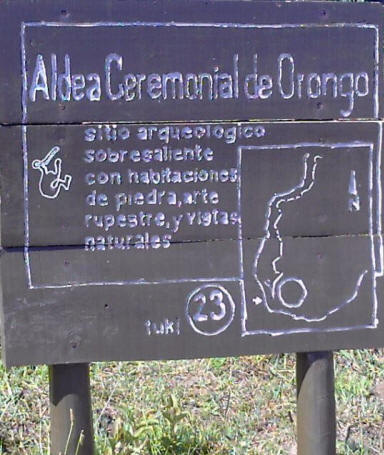
Easter Island: Sign marking the entrance to the Orango ruins, an extinct
volcano with a village used for religious events.
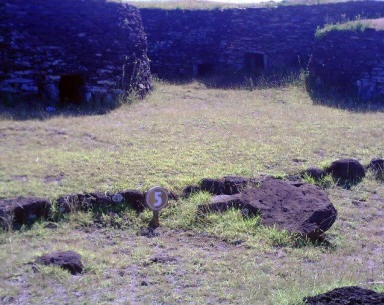
Easter Island: Ruins of dwellings at the Orango ruins on the rim of an
extinct volcano.
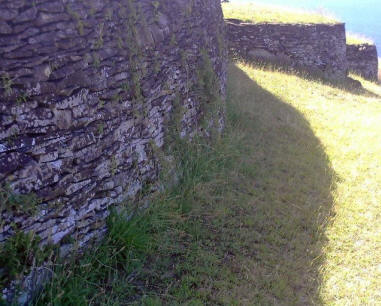
Easter Island: Ruins of dwellings at the Orango ruins on the rim of an
extinct volcano.
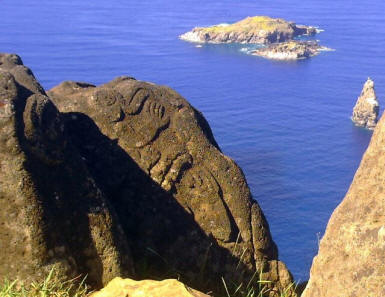
Easter Island: Islands off the southern shores of the islands near the
Orango ruins on the rim of an extinct volcano with a village used for
religious events.
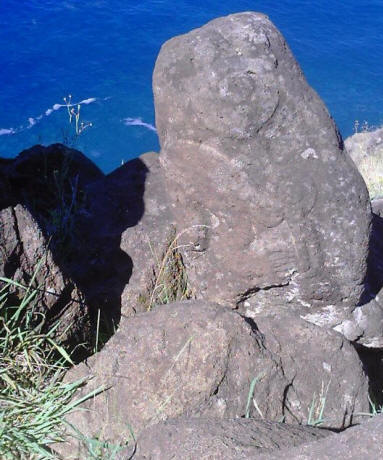
Easter Island: Petroglyphs cover many large stones around the southern
shores of the area near the Orango ruins on the rim of an extinct volcano
with a village used for religious events.
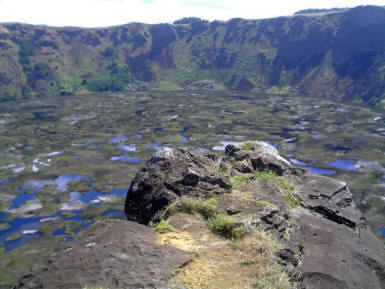
Easter Island: Looking down into the extinct volcano at the Orango ruins.

Easter Island: Looking down into the extinct volcano at the Orango ruins.

Easter Island: On the rim of the extinct volcano at the Orango ruins.
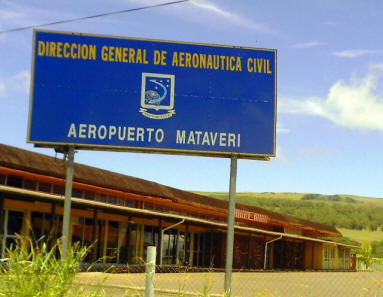
Easter Island: The airport is deserted except during the time when the few
flights arrive and depart several times each week.
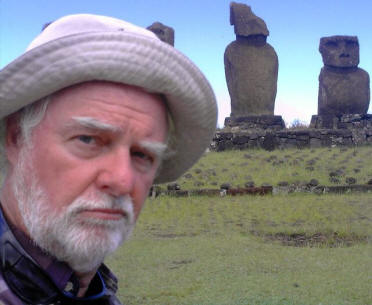
Easter Island: Now that I've seen all these big ugly broken stone statues
I'm wondering why I came to this place of inhospitality and obscenely high
prices for everything. |


























































































































































































